フィリピン・ルソン島北部のバギオを拠点に、コーディリエラ山岳地方で活動する環境NGO「コーディリエラ・グリーン・ネットワーク(CGN)の日本人インターンによるブログです。 活動紹介のホームページはhttps://cordigreen.jimdo.com。 以前のインターン体験ブログはこちらameblo.jp/cordillera/。 問い合わせは[email protected]まで。
Don't wanna be here? Send us removal request.
Text
野鳥調査を通じたタジャン農家とインドネシア農家の交流プログラム 6・7日目
いよいよこのツアー最後のブログとなりました!
6日目
この日は丸1日かけて移動日!お世話になったステイ先のラヨグ・カントリー・ファームを出発し、まずはタジャン町からバギオ市へ5時間かけて移動し、またそこから4時間かけて240kmほど離れたザンバレス州にあるスービックへと向かいます。スービックに着いたのは夜の8時!��の日に行われるエコツアーに向けてゆっくり宿で休みました。

*スービックは30年ほど前まで米軍基地があり、アメリカの影響を強く受けていた場所でもあります。
7日目
ホテルで朝食をとった後、早速エコツアーに参加しました。この地域に住む先住民のアエタ族の人たちに森の中を案内してもらいながら散策していきます。アエタ族はフィリピンに最初に渡来した民族と言われています。今回訪れた場所は元米軍スービック基地の中にあり、森の中で暮らす彼らの生存能力の高さから、当時はアメリカ軍に対してサバイバル訓練を行っていたそうです。そのためのトレーニングエリアとしてこの森が原生林のまま保存されることになったとのこと。とても興味深い話です。

まずは、最初にウェルカムドリンクとしてバンブーティー、グヤバノ(サワーソップ)ティー、アヌナス(シュガーアップル)ティーをいただきました。どれもすっきりとした味わいで、特にアヌナスティーが美味しかったです。そのほかにも蒸したさつまいもとオーガニックの蜂蜜もおやつとしていただきました!これらの全てはこの森で採れたもので、彼らが持っている豊かな資源を感じることができました。

*みんなでウェルカムドリンクを楽しんでいます。
ツアーが始まると、森林の中を歩きながら、薬草として使っている植物の解説や、竹を使った火の起こし方、竹筒でのお米の炊き方など、アエタの人たちの日々の暮らしの知恵をたくさん聞くことができます。特に竹を使った火起こしは、Klasik Beansのみんなもタジャンのコーヒー農家のみなさんも苦戦していたのですが、アエタの方はわずかな時間で火を起こしていて、さすがでした。

*竹に切り込みを入れて摩擦で火を起こしている様子。

*竹筒で炊いたご飯。ふっくら炊けていて、みんなでおいしく食べました!

*シャンプーとして使われる木の樹液。化学的なものを持ち込まない森での暮らしを紹介してくれました。
ツアーの終盤には滝が流れているところで、水浴びをしました。たくさん歩いたあとの水浴びはとても気持ちよかったです。スタート地点に戻ってきたら、アエタの方が用意してくれた昼食をみんなでいただきました。

*木の皮をすりつぶしてできた天然のハンドソープで手を洗っている様子。
このツアーはMAD Travelという社会的企業が企画しているもので、今回はこの団体のスタッフであるアンジュさんがガイドとして私たちを案内してくれました。アエタの人たちは主に移動焼畑や狩猟採集をして暮らしていた人たちで、タジャンの農家の人たちが住むコーディリエラ地方の先住民と同様に貨幣経済の影響を受け、生計手段も変化しています。
MAD Travelはフィリピンの様々な場所でコミュニティベースで行うエコツアーをコーディネートしていますが、アエタ族の森を訪ねるエコツアーは、そのうちの一つです。ツアー参加費は一人3500ペソ(8700円くらい)と高いですが、利益はツアーを手伝ってくれているアエタの人たちへの賃金、そしてそのコミュニティの植林活動の資金として使われるそうです。実際に2017年以降に、ザンバレ��州にある山で6万2千本もの植林をしたそうで、エコツアーを通して持続可能なサイクルを生み出そうと取り組んでいます。ホームページを訪れるとより詳しいことが書かれているのでぜひ覗いてみてください!!
これでプロジェクトの全日程を終えました。タジャンの農家のみなさんはバギオを経由してタジャンへと帰り、私はKlasik Beansのみなさんをマニラの空港まで送りに行きました。1週間の滞在でしたが、別れる頃にはとっても寂しくなるほど、濃い時間を過ごしました。

*アエタの方たちとタジャンの農家さん、Klasik Beans、CGNのみんなで集合写真。右下2番目の男性がMAD Travelのアンジュさん。
全体を通した感想
この1週間を通して、毎日新たな発見とたくさんの学び、刺激を受けてきました。日本にいた時は、コーヒーが作られる裏側なんて考えたこともなかったのですが、こんなにも農家の人たちの地道な努力が必要なのかと驚きと共に尊敬の気持ちでいっぱいになりました。日本はコーヒーの生産地ではないですが、コーヒーの消費量は多く、コンビニで簡単に安いコーヒーが飲めます。一方で最近では、「サスティナブル」、「エコ」、「オーガニック」などといった環境や社会への配慮も商品の価値をアピールする要素として重視され、消費者側には意識する人が増えてきましたが、何をもって持続可能なのか、環境にやさしいのかまだまだ曖昧な部分も多いです。
このプロジェクトは、「野鳥」を一つの指標としてコーヒーと環境を結ぶことで、どのようにマーケティングに生かすことができるかを考えるということがテーマですが、まずはコーヒー生産者の人たちにも野鳥の大切さを知ってもらうことから始まりました。Klasik Beansのみなさんは栽培からマーケティングまで自分たちで行っていて、パッケージに鳥のイラストを使うなど、コーヒーの品質、環境保全、マーケティングという3つの要素をどれ一つとしておろそかにすることなく、それぞれがつながることが重要だという認識をもって実践しています。
しかし、まだまだコーヒー農家として駆け出しのタジャンの農家の人々は、コーヒーの栽培に関しても、その後の加工やマーケティング、そして味のクオリティについても学んでいる最中です。自分たちの環境を守ることがコーヒーの味や値段をよくすることにつながると、今回の交流プログラムで知ってもらえたのではないかなと思います。
また、コーヒーを飲むのが大好きな人には、サガダで行ったようなコーヒーファームツアーの需要があったり、アエタ族のエコツアーのように自分たちが持っている環境と伝統的な暮らしを守りつつ観光業を行うことができるということも、タジャンの農家とKlasik Beansのみなさんに体験してもらえたのかなと思います。特に年に1回しか収穫がないコーヒー農家は、給料が年に1回しかないと考えると、定期的に得られる収入源も必要です。環境を守りながら、自分たちの文化も守り、暮らしも守っていく。今回ツアーをいろいろ体験したことによって、それらの全てがうまく組み合わさるようなアイデアを考えるきっかけになったらよいなと思います。
今回はインドネシアからKlasik Beansのみなさんがフィリピンのコーヒーファームを訪れてくれましたが、今年の7月ごろに、今度はタジャンの農家がKlasik Beansのコーヒーファームを見に行きます!引き続きプロジェクトは続きますのでぜひ楽しみにしてください!!
みなさま毎回長いブログにお付き合いいただきありがとうございました!また、次のブログでお会いしましょう^^

*空港で最後にみんなで撮った写真。Klasik Beansのみなさん本当にありがとうございました!!
Exchange program between farmers in Tadian and Indonesia through bird surveys - Day 5 & 6
Finally, this is the last blog of this tour!
Day 6
This day was dedicated entirely to travel. We left our accommodation “Layog Country Farm” where we had been so warmly hosted, then we headed to Baguio city, five hours from Tadian. After that, we drove another four hours to Subic in Zambales Province which is 240 km away from Baguio. We arrived there around 8pm! We rested well at the hotel for an eco-tour scheduled for the next day.
Subic was once home to a U.S. military base, which closed about 30 years ago. As a result, the area still shows strong American influence.
Day 7
After breakfast at the hotel, we immediately set off on the eco-tour. Guided by members of the indigenous Aeta community, we explored the forest. It is said that Aeta is the first tribe who have settled in the Philippines. The forest we visited lies within the former U.S. military base, and due to the Aeta's impressive survival skills, they were once recruited to train American soldiers in survival techniques. Thanks to this role, the forest has been preserved in its natural state—a fascinating bit of history!
We were welcomed with drinks made from bamboo, guyabano (soursop), and anonas (sugar apple). Each had a clean flavor, but the anonas tea was my personal favorite. Along with the drinks, we were also served steamed sweet potatoes and organic honey, all sourced directly from the forest. It was a beautiful reminder of the richness of local resources.
Everyone is enjoying the welcome drinks.
As the tour progressed, the Aeta shared their traditional knowledge with us while we walked through the forest. They explained the medicinal uses of different plants, demonstrated how to start a fire using bamboo, and showed us how to cook rice in bamboo tubes. The fire-starting in particular was challenging—both the Klasik Beans team and the Tadian farmers struggled—but the Aeta could spark a flame within minutes. It was truly impressive.
Demonstrating fire-making with bamboo.
Rice cooked in bamboo—soft and fluffy! We all enjoyed it together.
Tree sap used as natural shampoo—showing us how they live in harmony with nature, without relying on chemicals.
Toward the end of the tour, we stopped at a waterfall and had a refreshing dip in the water—just what we needed after the long walk. Back at the starting point, we had a delicious lunch prepared by our Aeta hosts.
This tour was coordinated by MAD Travel, a social enterprise, and this time, Mr. Anju, a staff member from this organization, guided us. The Aeta people mainly lived by shifting cultivation, hunting and gathering. However, like the indigenous people of the Cordillera including Tadian people, their lifestyle has been changing due to the influence of the monetary economy.
MAD Travel coordinates community-based eco-tours across various parts of the Philippines, and this tour to the Aeta forest is one of them. The tour fee is quite high—around 3,500 pesos (about 8,700 yen) per person—but the proceeds go toward fair wages for the Aeta guides and funding for reforestation efforts in that community. In fact, since 2017, they have planted over 62,000 trees in the mountains of Zambales. Their goal is to create a sustainable cycle through eco-tourism. You can learn more about their efforts on their website—definitely worth a visit!
With that, the program officially came to an end. The Tadian farmers headed home via Baguio, while I accompanied the Klasik Beans team to the airport in Manila. Although our time together lasted only a week, the experience was so rich and meaningful that it was hard to say goodbye.
Final Reflections
Through this one week, I encountered new discoveries, learned a great deal, and was inspired every single day. When I was in Japan, I never really thought about what goes on behind the scenes of coffee production—but now, I’m filled with both surprise and respect for the dedication and hard work of coffee farmers.
Although Japan doesn’t produce coffee, its consumption is high, and people can easily buy a cheap cup at a convenience store. At the same time, buzzwords like “sustainable,” “eco-friendly,” and “organic” have become popular, with more and more consumers becoming conscious of environmental and social issues. However, the actual meaning of what makes something truly sustainable or environmentally friendly is still often vague.
This project focused on using wild birds as a key indicator to connect coffee production with environmental conservation, and to explore how that connection could be used in marketing. But it all started with helping coffee producers themselves understand the importance of birds.
The Klasik Beans team handles everything from cultivation to marketing. They include bird illustrations on their packaging and work with the understanding that coffee quality, environmental protection, and marketing are all interconnected and equally important—not something to compromise on. They put that belief into practice.
On the other hand, the coffee farmers in Tadian are still in the early stages. They are just beginning to learn not only about coffee cultivation, but also about processing, marketing, and improving the flavor. I believe this exchange program helped them realize that protecting their environment can directly contribute to better coffee quality and higher value.
For those who love drinking coffee, there is clearly interest in activities like the coffee farm tour we did in Sagada. And as the Aeta eco-tour showed, it’s possible to protect both the environment and traditional ways of life while also engaging in tourism. I think both the Tadian farmers and the Klasik Beans team got to experience that firsthand.
Especially for coffee farmers who only harvest once a year—meaning they essentially only get paid once a year—it’s crucial to have additional sources of income. Protecting the environment, preserving culture, and sustaining a livelihood: through the various tours we experienced, I hope this trip sparked some ideas on how these elements can be combined in a meaningful and sustainable way.
This time, the Klasik Beans team from Indonesia visited coffee farms in the Philippines. But around July this year, it will be the Tadian farmers’ turn to visit the Klasik Beans coffee farms in Indonesia! The project is ongoing—so please look forward to what comes next.
Thank you so much for reading these long blog posts each time! See you again in the next one.
Our last group shot at the airport. Thank you so much to the Klasik Beans team!
4 notes
·
View notes
Text
野鳥調査を通じたタジャン農家とインドネシア農家の交流プログラム 5日目
このプログラムも残り3日となりました。
この日はそれぞれの宿泊先で朝食をとった後、野鳥調査をしていたNPO法人バードリサーチのみなさんはバギオへと向かい、残りのKlasik Beans(インドネシアのコーヒー農家)とタジャンの農家、そしてCGNスタッフはサガダ町からタジャン町へと戻ります。

*最後にみんなそろって集合写真!バードリサーチのみなさんありがとうございました!
道中に展望台があり、そこで一休憩。展望台からは少し先にタジャン町を見下ろすことができます。その後ろ側を振り返ると、タジャンがある��ウンテン州の隣にあるベンゲット州側を見渡すことができます。そこには野菜畑が果てしなく広がっています。まりこさんによると、ここ20年で山だったのが一面野菜畑になってしまったそうです。この辺りでは、商業用の野菜を作るために農薬などを大量に使っていて、その農薬で汚染された水がタジャンにまで流れてしまっているそうです。農家の人にとっては必要な生計手段だとしても、野菜畑側に森林が全くないのを見ると、自分にできることはなんだろうかと考えさせられました。

*こちらは展望台から見えるタジャン側の写真。まだまだ森林があるのが見られます。

*反対のベンゲット州側を見ると、このように野菜畑が一面に広がっています。商業的農業が盛んなベンゲット州の影響は徐々に他の州まで広がり、山を野菜畑に変える人が増えているようです。
展望台を後にし、向かった先はタジャン町のカダド・アナン(Cadad Anan)村。この日のプログラムの主な目的はタジャンのコーヒー農家を何軒か回り、インドネシアチームと村の人たちが交流することです。その一つ目の村としてカダド・アナン村へ。バランガイホール(公民館)にあるコーヒーの加工所を訪問した後に、クレフラゼット・ファームClefrazet Farmを訪れました。この村にはオールド・ティピカ種というアラビカ種の原種と言われるほど、古いコーヒーノキが植えられています。村の長老たちによると、樹齢は100年以上もあるそうです!すごい歴史!しかし一方で、最近は収穫量が伸び悩んでいるとのこと。Klasik Beansのみなさんに栽培に関するアドバイスを求め、意見交換をしました。

*写真左側に座っているのは村のコーヒー農家の人たち。正面に座っている右の女性が農園オーナーのエデンさん。右側にはKlasik Beansのみなさん。
次の目的地はダクダック(Dacdac)村。ご飯を食べた後、村の方がタジャンの伝統的なコーヒーの焙煎の仕方を教えてくださり、Klasik Beansのみんなにも実際に体験してもらいました!
まずは焙煎から。ここでは生豆が入った鍋を薪で起こした火にかけ、木べらで混ぜながら煎っていきます。パチパチと音がしてきたら煎り上りが近い合図。そこからは焦げるまでがとても早いので火を止めるタイミングが難しく、どうしても深煎りになりやすいとのこと。みんなで交代して豆が焦げないようにかき混ぜながら焙煎しました。

*Klasik Beansのゼナが昔ながらの村の焙煎方法を体験している様子。
焙煎が終わったら、竹ざるにコーヒー豆を空け、ざるを器用に前後に振ってコーヒー豆を上下に動かしながら、息を吹きかけて余分な薄皮などを飛ばしていきます。農家の方は難なくこなしますが、意外と難しく繊細な作業です。

そして豆を挽く作業へ。といってもコーヒーミルなどの器具はないので、臼と杵を使い豆を粉砕していきます。

*このように篩(ふるい)にかけたら完成です!
コーヒーを飲む準備が整ったら、Klasik Beansのセンディがドリッパーを使ったコーヒーの淹れ方を紹介してくれます。3日目のブログでも書きましたが、普段はやかんで煮出して苦いコーヒーを飲んでいるタジャンの人々。ダクダック村の人もいつもとは違う味に驚いていました。そしてその後インドネシアのコーヒーもダクダック村の人たちに飲んでもらいました。みんな美味しいと言いながら飲んでいました!さらに、Klasik Beansのみんなは農家の人にもわかりやすい簡易なカッピング方法で、村の人たちにカッピング体験をさせてくれました。2日目のブログに書いたように、コーヒーの味に正解や間違いはありませんし、いきなりプロのようにコーヒーを評価することはできません。大事なのは淹れ方、お湯の量などでどのくらい味が変わるのかをタジャンの農家のみなさんに知ってもらうことです。農家の人たちはどのコーヒーがおいしかったかと話しながら、インドネシアチームと意見交換・交流していてとても良い時間でした。

*カッピングの様子。右の黒い帽子の若者がセンディ。ジャカルタのコーヒーショップでバリスタとして働いています。

*左がKlasik Beansのウデンさん、右がダクダック村のコーヒー農家の方。二人ともいい笑顔!
そして最後の訪問先はカブナガン村のベナフィン・ファームBenafin Farm。CGNのコーヒープロジェクトの受益者の一人であり、タジャンで最も熱心なコーヒー農家の一人であるエリーさんのファームにお邪魔させていただきました。ここではアグロフォレストリーを忠実に実践しています。コーヒーだけでなくさまざまなフルーツや野菜が植えられているファームを見学しました。そして実際に育てているコーヒーノキの状態を、Klasik Beansのみなさんに見てもらいました。

*ウデンさんによると、このコーヒーノキは枝の剪定が必要とのことでした。また、雨季に苗木の周りを枯れ草などで覆っていたために湿度が高くなりすぎてしまったのも生育が思わしくない原因だそう。本当にこまめな手入れが必要です!!
非常に有意義な時間を過ごし、気づいたらすっかり日も暮れて夜に。再びラヨグ・カントリー・ファームLayog Country Farmへ戻りタジャンでの最後の一夜を過ごしました。
6日目へ続く→→→
Exchange program between farmers in Tadian and Indonesia through bird surveys - Day 5
There are only three days left in this program.
On this day, after having breakfast at each accommodation, the members of Bird Research, the NPO conducting the bird survey, headed to Baguio. Meanwhile, the remaining participants — the Klasik Beans team (Indonesian coffee farmers), the farmers from Tadian, and the CGN staff — traveled back from Sagada to Tadian.
At the end, we all gathered for a group photo! Thank you so much to everyone from Bird Research!
On the way back, we stopped at an view deck for a short break. From the deck, you can see the town of Tadian below. Turning around, you get a view of the Benguet side, which borders Mountain Province where Tadian is located. There, an endless expanse of vegetable fields stretches out. According to Mariko san, what used to be forested mountains 20 years ago has turned entirely into vegetable farmland. She also mentioned that in this area, large amounts of pesticides are used for commercial vegetable farming, and the contaminated water flows downstream into Tadian. Even though farming vegetables is an essential livelihood for local farmers, seeing the complete absence of forests in that area made me reflect on what I can do for the environment.
This is a photo of the Tadian side, taken from the observation deck. You can still see a lot of forest remaining.
In contrast, the Benguet side looks like this — covered entirely with vegetable fields. The spread of commercial farming in Benguet seems to be gradually influencing neighboring provinces as well, with more people converting land into vegetable farms.
After leaving the view deck, we headed to Cadad Anan, a village in Tadian. The main objective for the day was to visit several coffee farmers in Tadian and facilitate interaction between the Indonesian team and the villagers. Our first stop was Cadad Anan. We visited a coffee processing facility located in the Barangay Hall (community center), and then moved on to Clefrazet Farm.
In this village, very old coffee trees known as Old Typica — said to be one of the original varieties of Arabica — are grown. According to the village elders, some of the trees are over 100 years old! An incredible history! However, they mentioned that recently the coffee yields have been stagnant. They asked the Klasik Beans team for advice on cultivation, and they exchanged ideas.
On the left in the photo are the local coffee farmers. The woman sitting in the center-right is Eden, the farm owner. On the right side are the Klasik Beans members.
Our next destination was Dacdac village. After having lunch, a local farmer taught us the traditional way of roasting coffee in Tadian, and the Klasik Beans team got to try it!
First, the roasting. Here, green coffee beans are placed in a pot and roasted over a fire made with firewood, stirring constantly with a wooden spatula. When you start to hear crackling sounds, it’s a sign that roasting is almost done. From that point, it’s easy to burn the beans, so judging the right moment to remove them from the heat is difficult — often resulting in a darker roast. We all took turns stirring carefully to prevent the beans from burning.
Here’s Zena from Klasik Beans experiencing the traditional village roasting method.
Once roasting was complete, the beans were poured onto a bamboo tray. The tray was skillfully shaken back and forth while gently blowing air to remove the thin outer skin. While the farmers made it look easy, it was surprisingly delicate work.
Here’s Jimmy, a coffee farmer from Tadian, demonstrating the technique.
Next came the grinding. Since there were no coffee mills, we used a mortar and pestle to crush the beans.
After sieving the ground coffee, it’s finally ready!
Once the preparations were complete, Sendy from Klasik Beans demonstrated how to brew coffee using a dripper. (As I mentioned in the Day 3 report, people in Tadian usually boil coffee directly in a kettle, resulting in a very bitter brew.) The villagers in Dacdac were amazed by the different taste. They also got to taste Indonesian coffee, and everyone enjoyed it, saying how delicious it was! Moreover, the Klasik Beans team introduced a simple cupping method so the farmers could experience tasting coffee in a new way.
As I wrote in the Day 2 report, there’s no right or wrong in coffee tasting, and it’s not something you master like a professional right away. What’s important is for the farmers to understand how the flavor changes depending on the brewing method and water quantity. The farmers discussed which coffees they liked best and had great exchanges with the Indonesian team.
Here’s a photo of the cupping session. The young man wearing the black hat is Sendy, who works as a barista at a coffee shop in Jakarta.
On the left is Uden from Klasik Beans, and on the right is a coffee farmer from Dacdac village — both smiling brightly!
Finally, we visited Benafin Farm in Kabunagan village. We were welcomed by Eli, one of the beneficiaries of the CGN coffee project and one of the most passionate coffee farmers in Tadian. Her farm is a wonderful example of agroforestry in practice. Besides coffee, she grows a variety of fruits and vegetables, and we had the chance to observe her farm and the condition of the coffee trees.
According to Uden, the coffee trees here needed pruning. Also, because the seedlings were covered with dried grass during the rainy season, humidity became too high, which negatively affected their growth. This shows how much careful maintenance is required!
After spending a very meaningful day, we realized it had already grown dark. We returned once again to Layog Country Farm and spent our last night in Tadian.
→→→ On to Day 6
2 notes
·
View notes
Text
野鳥調査を通じたタジャン農家とインドネシア農家の交流プログラム 4日目
ようやく4日目です!
この日は朝からステイ先のラヨグ・カントリー・ファームのデッキから雲海が見れて素晴らしい1日の始まりを迎えることができました!!

*雲海はいくつかの条件が揃わないと見ることができないそうでラッキー!!
4日目のプログラムはタジャンの隣町サガダ訪問です!
車で1時間半ほどの距離にあるサガダは観光名所として有名で、マニラからだけでなく外国からもたくさんの人が訪れます。また、コーディリエラ地方の中でも、現在も伝統文化の継承を実践しているコミュニティです。サガダにはインドネシアのKlasik Beansと私たちCGNだけでなく、タジャンのコーヒー農家7名も一緒に行きました。私たちがサガダを訪れた目的は、コーヒー生産地としてとても有名なサガダが、コーヒー栽培とエコツーリズムをどのように関連づけて実践しているのかを学ぶためです!
朝ご飯を食べた後、ステイ先のラヨグを出発し、11時頃にサガダに到着しました。サガダはコーディリエラ地方の他の観光地に比べると観光システムが整っていると言えます。サガダの観光スポットに行く場合は事前に観光省のオフィスで登録し、ガイドの同行が必要です。
前述したように伝統文化を今も尊重しているサガダでは、コミュニティの長老たちの話し合いで決まったことは絶対なのだそうです。観光スポットの近くで葬式があり、そこへは外部者の立ち入りはできないと長老が言えば、その周辺は立ち入り禁止となります。観光客が仮にアクティビティを予約していたとしても、こういった伝統のしきたりにより遂行できないと言われてしまうことも少なくないのだそうです。今回、私たちがガイド協会にアレンジをお願いしていたコーヒー栽培地へのエコトレッキングも、近くで葬式があるということで、別のコーヒー農園での体験ツアーに内容が変更となりました。しっかりとコミュニティで伝統文化を守っていこうという姿勢があるおかげで、「伝統文化の村・サガダ」としてのブランディングに成功しているのかもしれません。
では実際にサガダの文化とはどのようなものなのか。まずはガンドゥヤン博物館Ganduyan Museumに学びに行きました。ここでは、館主の方の説明を聞きながら、展示されている伝統的な生活用具や武器、工芸品を見ることができます。中には第二次世界大戦で日本兵が残していったヘルメットなども展示されていました。意外と知られていませんが、第二次世界大戦末期に日本軍はマニラからここコーディリエラ地方まで北��してそのまま終戦を迎えたため、このような日本軍の遺品がルソン島北部の山奥に残されているのです。

*暮らしに使われてきた様々なカゴ類の展示。米などの穀物や豆の貯蔵用、狩りに行く時に弁当やタバコを入れたカゴなど、用途によって形はいろいろです。
博物館で工芸品を堪能し、昼食をとった後はケイブマン・コーヒー農園Caveman Coffee Farmへと向かいました。ここではコーヒーの収穫から加工、焙煎、試飲までの一通りを体験することができます。隣町のタジャンのコーヒー農家の人にはサガダのコーヒーが有名なのはよく知られているので、みんな興味津々な様子でした。
また、Klasik Beansnの人たちも乾燥中の豆の匂いを嗅いで、「これはこんな匂いがする」など意見を共有しあっていて、さすがコーヒーのプロフェッショナルだな〜と思いました。私も真似して同じことをしてみましたが、豆の匂いを嗅ぎ分けることなんてできませんでした(笑)。

*乾燥中のコーヒー豆を嗅いでいるKlasik Beansのアンドリたち。
余談になりますが、ここのファームからはずっと向こうの崖に棺桶があるのが見えます。これはサガダの特徴的な伝統文化の一つで、死者を棺桶に入れて崖に吊り下げる風習があったのだそうです。双眼鏡で覗くと棺桶の隙間から骸骨がはみ出ているのが見えました。全部人の力で崖の斜面へ棺桶を運んでいったそうですが、それにしても信じがたいくらいすごい場所にお墓があります。

*この写真はコーヒーファームから見えたものとは別の場所ですが、サガダではいろいろな所に棺桶が吊るされています!
コーヒーファームツアーを楽しんだ後は、そのままスマギン洞窟Sumagin Caveという洞窟へ行きました。私はただ洞窟に入って少し歩いて終わるものだと舐めていたら、バチバチのアドベンチャーでびっくり(笑)。入口を入ったところから上方にコウモリたちの鳴き声を聞き、下に落ちている彼らの糞を踏まないように、岩壁についているのを触らないように気をつけながら洞窟の中に入っていきます。「安全靴をはかなくて��いけない」とかいう概念はないらしく、それどころか途中から履いていたビーサンも脱ぐようガイドに言われ、ツルツル滑る洞窟の中をなんとか手で岩壁を触って行き先を探りながら、時には崖みたいなところをロープを使って登り降りし、上から垂れてくる水滴と地面にあふれている地下水でビショビショになりながら進んでいきます。
安全面でも衛生面でもこんなカジュアルにできるようなものなのか??と日本人としては思ってしまいそうですが(笑)。。。日頃から山でのコーヒー栽培や農業で鍛えているタジャンの人もインドネシアの人もフィジカルが強いので、ものともせずに進んでいきますが、山育ちでも何でもない環境でぬくぬくと育った私は転ばないようにするのに必死で、ガイドが説明してくれる岩の形などの周囲の景色をあまり楽しめずに終わってしまいました(笑)。

*洞窟の中の様子。タジャンからの参加者の一人は小さいお子さんを連れてきていて、時には子供を抱えながら崖を登り降りしていて終始ヒヤヒヤしました!!
無事に生還した後は、宿泊施設にチェックインし濡れた洋服を着替え、ガイア・カフェGaia Cafeへ夕食を食べに行きました。アクティビティを終えて空腹な私たちをボリューム満点のプレートが迎えてくれます。

*食べきれないほどのボリュームでした!
お腹いっぱいになったら、そのままみんなでミーティング。今日1日の振り返りだけでなく、これまでの3日間のフィードバックも共有しました。私たちはまだ残りの日程がありますが、バードリサーチのみなさんは次の日の朝にはマニラに向かって出発する予定になっており、ここが最後の全員でのミーティングの機会ということで、しっかりと感想を共有し合います。
このプロジェクトのテーマにあるように、野鳥が生息することがコーヒー栽培地の環境保全を証明することになります。それには、まずコーヒー農家の人たちに野鳥の果たす役割を理解してもらうことが重要です。Klasik Beans側からもタジャン側からも、もっと自分のファームにいる野鳥を調べたいとか、普段から意識して観察したいなどの感想が出てきて、これだけでもバードリサーチの野鳥調査の専門家がはるばる来てくださった意味があったと感じました。
タジャンの農家たちが抱える問題は、コーヒー栽培に関心を持っている若い世代がいないということです。それに対して今回来てくれたKlasik Beansのみんなは20代などの若い農家。あるタジャンの農家の方は、「自分たちは年寄りばかりで、コーヒーもハンドドリップで飲まないから味のクオリティがわからない。あなたたちは若くて、それだけでもリスペクトに値するのに、さらにクオリティまでわかるなんて本当にすごい」と言っていました。
それを聞いたKlasik Beansのウデンさんは、「自分たちも設立当初はおもに野菜を栽培する農家ばかりで、しかも50歳以上がほとんどでした。でもKlasik Beansが農家の子供たちのための塾をつくり、コーヒーの栽培からマーケティングまでのノウハウを教えたり、どうやって自分たちの土地の自然環境をケアするかをしっかり伝えていきました。その結果、今では50歳以下の農家が多くなりました」と経験を共有してくれました。Klasik Beansの次世代に繋げていこうとする取り組みと努力が素晴らしい!!
サガダのエコツーリズムに関して、冒頭に説明したように最初に観光省��登録した際に注意事項の動画を見せられたのですが、「騒音を立てない」などの超基本的なことも含めて20個くらいの禁止事項があり、私はちょっと厳しすぎないかな?と思いました。しかし、反対にKlasik Beansのウデンさんはとても良いシステムだと言う意見。彼の話では、インドネシアのバリ島では、観光客がツアーガイドを通さずに個人でバイクを借りて好き放題の場所でお酒を飲んだりしていて収拾がつかないのだそうです。それを聞いて確かに観光客からしたら自由の方が良いけど、自分が住民の立場だったら迷惑と感じることもあるなとハッと考えさせられました。
このプログラムに参加させてもらい、インドネシアやタジャンの人たちと旅をする中で様々な意見を聞く機会に恵まれ、今までの自分の考えにはなかった新たな発見があり、考えさせられることばかりです。
とくに、Klasik Beansが、小学校の時から学校教育とはまた別にコーヒーの栽培からマーケティング、さらには自分たちの伝統文化まで学ぶことができる塾(インフォーマル・スクール)を運営していて、農家の子供たちが自然や文化など、学校では教えてくれない暮らしに密着したことを学べる環境があるということが本当に素晴らしいと思います。
日本では決められたことや学校で教えられる勉強が全てで、それができることが賢いとされますが、本当に必要な知識は学校の中というよりも、外にあるのではないかなあと、Klasik Beansのみんなの話を聞いて、考えさせられていました。
ツアー5日目の報告もお楽しみに!!!

*それぞれの感じたことや意見を聞くことができてとても良い時間になりました。
Exchange program between farmers in Tadian and Indonesia through bird surveys - Day 4
Finally, it's Day 4!
We started the day with a breathtaking view of a sea of clouds from the deck of our accommodation, Layog Country Farm—a perfect beginning to the day!
Apparently, seeing a sea of clouds depends on several weather conditions aligning, so we were very lucky!
The main program for the day was a visit to the neighboring municipality of Sagada. Sagada, located about an hour and a half away by car, is a well-known tourist destination that draws visitors not only from Manila but also from abroad. Compared to other areas in the Cordillera, Sagada is notable for actively preserving its traditional culture. Joining us on the visit were Klasik Beans (Indonesia), CGN, and seven coffee farmers from Tadian. Our purpose in visiting Sagada was to learn how this well-known coffee-producing area is integrating coffee farming with ecotourism.
After breakfast, we left Layog and arrived in Sagada around 11 a.m. Tourism in Sagada is more systematically organized compared to other parts of the Cordillera. Visitors are required to register at the Department of Tourism office before entering any tourist site, and it’s mandatory to be accompanied by a local guide.
As mentioned earlier, Sagada continues to honor its traditional customs. Decisions made by the community elders are considered final. For example, if a funeral is being held near a tourist spot and the elders prohibit outsiders from entering, that area becomes off-limits—even if tourists have already made reservations. In fact, our eco-trekking tour to a coffee farm had to be changed at the last minute due to a nearby funeral. The local Guide Association arranged for us to visit a different coffee farm instead. Sagada’s strong commitment to protecting and honoring its traditional culture may be one of the reasons it has succeeded in branding itself as a “traditional village.”
So what is Sagada’s culture like, exactly? To find out, we visited the Ganduyan Museum, where the owner walked us through displays of traditional tools, weapons, and crafts. Surprisingly, there were even helmets left behind by Japanese soldiers during World War II. Toward the end of the war, the Japanese army moved north from Manila to the Cordillera, which explains why such relics can still be found deep in the mountains of Luzon.
There were many types of baskets on display, each designed for a specific use—like storing rice or beans, or carrying food and tobacco during hunting trips.
After exploring the museum and enjoying lunch, we headed to the Caveman Coffee Farm, where we got to experience the full coffee process—from harvesting and processing to roasting and tasting. The Tadian farmers were especially curious, since Sagada coffee is quite famous in their region. The members of Klasik Beans were also in their element, sniffing the drying beans and sharing their impressions—true coffee professionals! I tried to copy them, but honestly, I couldn’t tell the difference in scent at all (haha).
Here’s Andri from Klasik Beans smelling the drying coffee beans.
As a side note, we spotted some hanging coffins on a distant cliff while at the coffee farm—part of Sagada’s unique funerary tradition. The deceased were placed in coffins and suspended on cliffs. Looking through binoculars, we could even see bones sticking out of the gaps. It’s said that these coffins were carried up the steep cliffs entirely by hand. The locations are so extreme, it’s hard to believe it was done by people!
This photo is from a different spot, but hanging coffins can be seen all over Sagada.
After the coffee farm tour, we headed straight to Sumaguing Cave. I had assumed we’d just take a quick walk through the cave and be done—but wow, was I wrong! It was a real adventure. As soon as we entered, we could hear bats overhead and had to carefully avoid their droppings on the ground. There was no requirement for special shoes—in fact, at one point the guide even told us to take off our sandals! We climbed slippery rocks, used ropes to descend small cliffs, and got drenched by underground water dripping from above and pooling on the cave floor.
As a Japanese person, I couldn’t help but wonder if this level of casual, hands-on adventure would ever be allowed back home, safety- and hygiene-wise (haha). But both the Tadian and Indonesian participants, used to working in the mountains, handled it all with ease. As for me—raised in a much more sheltered environment—I spent most of the time just trying not to slip, and barely had the chance to take in the scenery that the guide explained about.
Inside the cave—one participant from Tadian brought a small child and had to carry them while climbing, which was nerve-wracking to watch!
After making it out safely, we checked into our accommodation, changed out of our soaked clothes, and headed to Gaia Café for dinner. After such an active day, we were starving—and the hearty plates of food really hit the spot.
The portions were massive—I couldn’t even finish everything!
Once we were full, we had a group meeting to reflect not just on today, but on the past three days of the program. This was our last all-group meeting, as the Bird Research team would be leaving for Manila early the next morning. Everyone took this chance to share their thoughts and experiences.
As the theme of this program suggests, the presence of wild birds is a strong indicator of a healthy coffee-farming environment. That’s why it’s so important for farmers to understand the role birds play. During the meeting, both the Tadian and Klasik Beans participants said they wanted to observe the birds on their farms more closely from now on. Just hearing that made me feel that the visit from the bird research specialists was truly worthwhile.
One issue that Tadian’s farmers are facing is a lack of younger generations interested in coffee farming. In contrast, many members of Klasik Beans are in their twenties. One Tadian farmer said, “We’re all getting older, and we don’t drink coffee using fancy hand-drip methods, so we don’t really understand coffee quality. You’re young—and that alone is impressive—but on top of that, you actually know what quality coffee tastes like. That’s amazing.”
To that, Uden from Klasik Beans shared their story: “In the beginning, most of our members were over 50 and mainly vegetable farmers. But we created a kind of informal school for the farmers’ children, where they could learn everything from coffee farming to marketing, and even how to care for the natural environment. Now, most of our members are under 50.” Their commitment to building a future for the next generation is truly inspiring!
As for Sagada’s ecotourism, when we registered at the tourism office, we watched a video that listed about 20 rules—including basic ones like “no loud noises.” I initially thought the rules were too strict, but Uden from Klasik Beans actually praised the system. He explained that in Bali, Indonesia, tourists often do whatever they want—renting bikes and drinking anywhere without guides, which has caused lots of issues. His comments made me realize that while freedom is nice for tourists, if I were a local resident, I might see things very differently.
This trip has given me so many opportunities to hear different perspectives from people in Tadian and Indonesia. It’s made me question some of my assumptions and opened my eyes to new ways of thinking.
One thing that really stood out was how Klasik Beans runs an informal school, separate from regular education, where kids can learn practical skills like coffee farming, marketing, and preserving their culture. It’s a place where they can learn about nature and daily life—things schools don’t usually teach. I think that’s amazing. In Japan, intelligence is often measured by how well you do in school and stick to the rules. But maybe the knowledge that truly matters is actually found outside the classroom.
Looking forward to sharing Day 5 with you soon!
1 note
·
View note
Text
野鳥調査を通じたタジャン農家とインドネシア農家の交流プログラム 3日目
3日目もハードスケジュールが続きます!
まずは町長への表敬訪問。インドネシアのゲストの方達のタジャン訪問の目的を説明するために町役場を訪問しましたが、残念ながら町長は不在だったので、副町長と秘書の方に代わりに挨拶をしました。
その後は、町役場の中にあるホールにてタジャンのコーヒー農家の人たちや農業省・観光省の職員の方も招いて、交流プログラムを実施しました。
プログラム内容
① タジャンの伝統舞踊の披露
② インドネシアチームからKlasik Beansの活動コンセプトについての紹介
③ Klasik Beansの活動を紹介するビデオ上映
④ インドネシアのコーヒー農園近くで見られた野鳥の紹介ビデオの上映
⑤ タジャンにおける伝統的な環境への取り組み「Lakon」についてのビデオプレゼンテーション(SDS Multimedia 制作)
その後はそのままホールでみなさんと一緒に昼食をいただきました。

*タジャンの伝統舞踊の様子。最後にはインドネシアの人も日本人も一緒に踊りに参加しました!
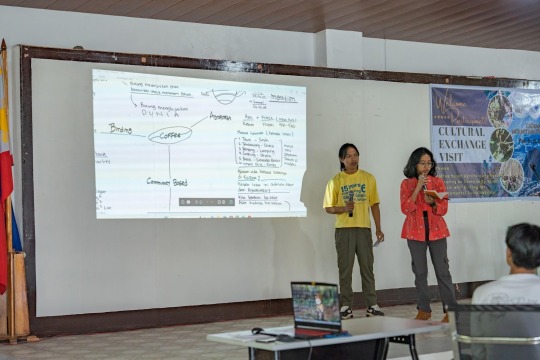
*センディとゼナによるKlasik Beansについての説明。Klasik Beansがどのように環境を守りながらコーヒー栽培を実践しているか図を用いながら解説してくれました。最後の質疑応答ではタジャン側から活発に質問が飛び交い有意義な時間でした!
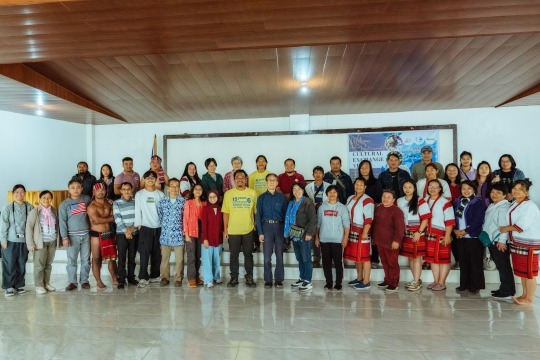
ステイ先のラヨグ・カントリー・ファームLayog Country Farmに戻り、このプロジェクトでタジャンの野鳥調査を担当しているNPO法人バードリサーチによるバードウォッチングを、ラヨグの敷地である森の中を散策しながら行いました。
このプログラムにはタジャンの農家の人たちも参加。同じタジャンにいながらラヨグを尋ねるのはほとんどの農家にとって初めてだったようです。私は初めてのバードウォッチングで、みんなが「あそこに鳥がいる!」と盛り上がっていても筋が悪いらしくいつまで経っても見つけられませんでした、、
でもKlasik Beansのみんなもタジャンの農家の人たちも夢中になって双眼鏡を覗いていてとても楽しそうでした。
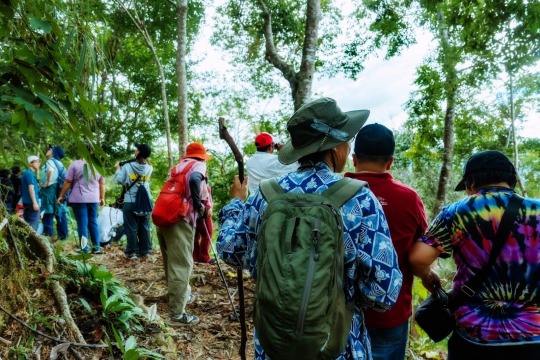
*鳥の鳴き声に耳を澄まし、聞こえてきた方角に双眼鏡を向けて、みんなバードウォッチングを楽しんでいました!
バードウォッチングを終えて、ファーム内の教会でKlasik Beansのセンディが淹れてくれたコーヒーをタジャンの農家の人たちに飲んでもらいながら、コーヒーやバードウォッチングの感想などを共有し合いました。ここコーディリエラではペーパードリップでコーヒーを淹れることはほぼありません。やかんでコーヒーを煮出して飲むのが一般的です。フィルターペーパーは使い捨てと聞いて、みんな「Sayang(もったいない)」と言っていました(笑)。
タジャンのコーヒー農家の人たちは、都市部や海外で人々がどのようにしてコーヒーを淹れて飲んでいるかを知らないということになります。Klasik Beansは欧米や日本にもコーヒーを輸出していて、海外で好まれるコーヒーに関する知識もすでに持っています。そういう農家の若者の一人であるセンディにコーヒーの淹れ方を教わることは、タジャンの農家の人たちにとっては大きな刺激になります。みんな今までに飲んだことない酸味と甘さがあるコーヒーに驚いていましたが、Klasik Beansのみんなに対してたくさん質問していてとてもいい機会になったのではないかなと思いました。

*センディがみんなにコーヒーを振る舞ってくれた様子。一度に大人数のコーヒーをハンドドリップで淹れるのはすごく時間がかかり大変なのですが、とても美味しいコーヒーを淹れてくれました。
続いて今回のバードウォッチングで見つけた鳥についての情報交換を行いました。みんなで見つけた鳥の特徴などを発表し合い、12種類の野鳥を発見できたことがわかりました。この地域では、鳥は畑の作物を食べてしまう害鳥として認識されていることもあったり、そのほかにもフクロウは不吉なことを予言する象徴であるという迷信があったりして良いイメージを持ってない農家が多くいます。フィリピンの野鳥のエキスパートであるジャンさんやバードリサーチの専門家のみなさんが、野鳥がエコシステムにどのような良いことをもたらすのか説明することによって、野鳥がアグロフォレストリーにとってどれだけ大事な存在かを知る良い時間となりました。

*バードウォッチングでみんなが見た鳥の種類を書き出していくバードリサーチの石田さんとジャンさん。図鑑を見ながらみんなとても盛り上がっていました!

*ラヨグで撮影された鳥の写真。フィリピンブルブル(日本ではヒヨドリと呼ばれる)。
その後は夕食の時間。ラヨグのスタッフが作ってくれたおいしい夕食をみんなでいただきました。
ここで、今回のツアーで滞在先となっているラヨグ・カントリー・ファームについて説明します。この場所は28ヘクタールの広さを持つ、アグロフォレストリー(森林農法)で全ての作物が作られているファームです。食べられる森(Edible Forest)を目指しているそうで、急な斜面の裏山を少し歩くだけでアボカドやレモン、パパイヤなど本当に多様なフルーツや豆類などの野菜が植えられているのが見られます。ゲストのために用意してくれる食事の食材の野菜やフルーツは、全てこのファームから採れた新鮮なものです。
アグロフォレストリーでは単一栽培ではなく、多様な樹木と農作物が一緒の土地に植えられているので、土壌が強くなります。さまざまな作物は森の中で育てられているので、そのエリアは災害に対してもレジリエンス(耐性)が強くなります。さらに農薬も全く使わないので、人間に対してはもちろん、水質や土壌など周りの環境にも悪い影響を与えません。オーナーのリナさんの話から、とっても大切にファームを手入れしてることが伝わってきて、毎食のご飯のありがたみをより一層感じました。どの料理もめちゃくちゃ美味しいんです!!
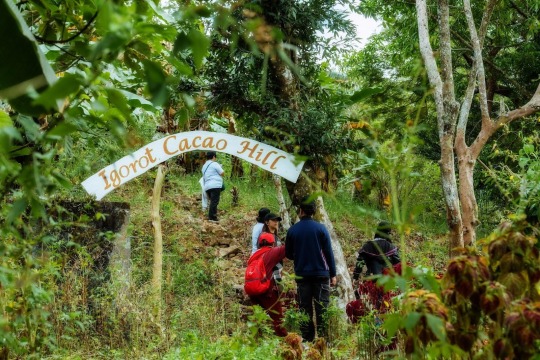
*それぞれの場所に何が植えてあるかを示す看板が建てられていて、ファームを探索するのにわくわくしました!
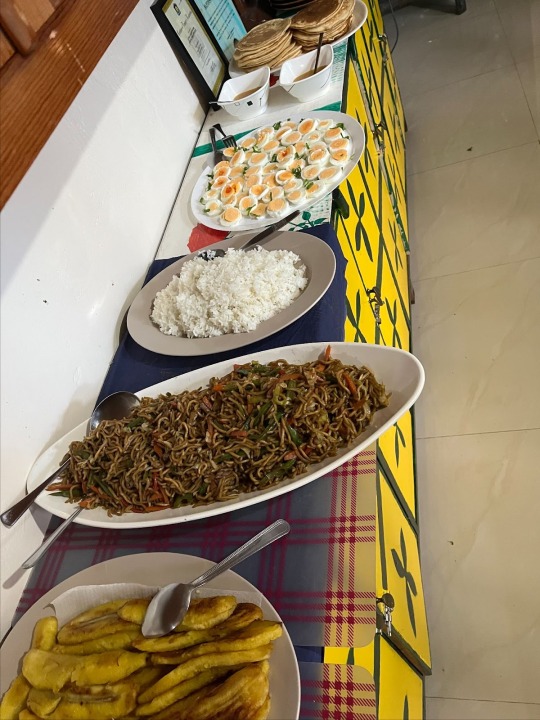
*Klasik Beansのみなさんはイスラム教信徒ということで、今回は豚肉を使わない料理を作ってくれました。この時のメニューは揚げバナナとパンシット(焼きそば)、ゆで卵、パンケーキ。今まで食べてきたパンシットの中でラヨグのものが一番美味しい!
夕食後タジャンの農家の人たちは帰りましたが、私たちはKlasik Beansのアンドリが制作したドキュメンタリービデオを見ました。ジャワ島の伝統文化がコーヒー収穫とどのように結びついているのか、どのように伝統文化を守っているのかを窺い知れ、とても興味深い内容で勉強になりました。何よりアンドリは私と年齢があまり変わらないのに、本当に高いクオリティのドキュメンタリーを作っていることに驚かされました! 同じ年代としてもっともっと自分も頑張らねばと思いました!!
さらにKlasik Beansのセンディが伝統楽器Karinding(口琴)を使ってサプライズ演奏をしてくれました。まだ3日しか彼らと一緒に過ごしていませんが、コーヒー農家としてだけでなく、バリスタとしても、またそれぞれがその他の得意分野でも技術を磨き続けていて、その姿勢にずっと感化されていました。

*Karinding(口琴)の演奏の様子。
いよいよ後半戦4日目に続きます!
Exchange program between farmers in Tadian and Indonesia through bird surveys - Day 3
Day 3 was packed with another full schedule!!
We started the day with a courtesy visit to the Tadian municipal office to explain the purpose of the Indonesian guests’ visit. Unfortunately, the mayor was unavailable, so we greeted the vice mayor and the secretary instead.
Afterward, we held a welcome party at a hall at the municipal building. We invited coffee farmers in Tadian, as well as representatives from the Departments of Agriculture and Tourism.
Program Highlights:
Traditional dance performance from Tadian
Presentation by the Indonesian team about the concept behind Klasik Beans
Video introduction of Klasik Beans’ activities
Video showing birds found around coffee farms in Indonesian
Video presentation on Tadian’s traditional environmental practice “Lakon”(produced by SDS Multimedia)
We then had lunch together at the same venue.
In the afternoon, we returned to our accommodation at Layog Country Farm and joined a birdwatching session led by Bird Research in charge of the bird survey in Tadian. The walk took place in the forested area within Layog’s property.
Local farmers from Tadian also joined this program. Even though they live in the same municipality, it seemed like the first time for many of them to visit Layog Country Farm. It was also my first time bird watching, I had a hard time spotting any birds - even when other participants were getting excited and shouting, “There it is!”
Still, everyone from Klasik Beans and Tadian farmers seemed genuinely excited, peering through binoculars and enjoying the experience.
When we went back from bird watching, it’s time to share our experiences while enjoying coffee that Sendy from Klasik Beans brewed for Tadian farmers at the chapel. Here in the Cordillera region, hand-dripped coffee is rare- locals usually boil coffee in a kettle. When they heard that coffee filters are disposable, they all exclaimed “Sayang (What a waste!)” haha. It means they don’t know how people in cities and other countries drip and drink coffee. Klasik Beans already has in-depth knowledge about coffee since they export their coffee to Europe and Japan. To learn about how to brew coffee from one of the young farmers from such a group will be definitely helpful to them. Although they were surprised that the coffee tasted sweet and sour, they asked a lot of questions to Klasik Beans, which seemed to be a good time for Tadian people.
Next, we shared what birds we saw in that bird watching. Everyone described the birds’ features, and we discovered that we had identified 12 different species. In Tadian, birds are often seen as pests because they eat crops.Some farmers also hold superstitions-like owls being omens of death-leading to negative views of birds. But through explanations from Jan and the Bird Research team, farmers learned how birds positively contribute to ecosystems and how important they are in agroforestry. It was a great opportunity to reshape their perspectives.
In the evening, we enjoyed a delicious dinner prepared by the staff in Layog.
Now, I would like to explain about Layog Country Farm, our accommodation for this project. It has 28 hectares of land, and all of the crops are produced by agroforestry. They aim to create an “Edible Forest”, and we can see a lot of kinds of fruits such as avocado, lemon and papaya, and kinds of beans and vegetables easily by having a short walk up the significantly steep slopes in the small hill. All the meals served to guests use fresh produce from the farm.
In agroforestry, it’s not a monoculture but a polyculture planted with many kinds of trees and crops in the same place, which strengthens the soil and increases resilience against natural disasters. No pesticides are used, so it’s safe for people, soil, and water. Hearing from the owner, Ma’am Lina, about how lovingly she tends to the farm made me appreciate each meal even more. And yes- the food was delicious!
After dinner, Tadian farmers went home but the rest of us watched a documentary video created by Andri from Klasik Beans. It was about their traditional culture in Java, especially its connection to coffee harvesting, and efforts to preserve these traditions. I was deeply impressed- not only by the content but by the high production quality. Andri is around the same age as me, and it really inspired me to push myself more!
As a surprise, Sendy from Klasik Beans performed a piece of a traditional instrument called “Karinding”(jaw harp). It’s only been three days since we started this program, but their attitude to learn for not only coffee farming and barista, but also their strong points. I had been influenced by them significantly.
Looking forward to sharing Day 4 next!!!
1 note
·
View note
Text
野鳥調査を通じたタジャン農家とインドネシア農家の交流プログラム 2日目
カッピング
2日目は、El Union Coffee BaguioでCGNのコーヒー豆を販売するKapi Tako Social Enterpriseの新豆のカッピングをすることから始まりました。インドネシアのKlasik Beansのみんなにも参加してもらい、CGNスタッフのリリーと、El Union Coffee Baguioのスタッフと一緒に行いました!
カッピングとは、コーヒー豆を全て同じ条件のもとで香りや味を評価する方法です。これを元に、ベストな焙煎・抽出に繋げていきます。淹れ方などで味に差が出てしまわないように、挽き方・粉量・時間・湯量等まですべて統一されています。
私にとって初めての体験。説明を聞きながら見よう見まねで挑戦してみました^^
今回は9種類のコーヒー豆をカッピングしました。

*サンプル豆にむらがあって誤差が出ないように、一つの種類の豆に対して2つまたは3つのサンプルを用意します(今回は2つでした)。
Step 1 コーヒー豆の匂いを嗅ぐ
まずは、お湯を注ぐ前に挽きたてのコーヒーを一つずつ匂いを嗅いでいき、どんな香りがするかメモします。
Step 2 ブレイク
次にお湯を注いで香りを嗅ぎます。お湯を入れてから4分後にスプーンを使って浮いてきたコーヒーの粉をかき混ぜて、香りが一気に出てきたときに匂いを嗅ぐ「ブレイク」と呼ばれる行為もしながら行っていきます。

*コップに触らないように嗅いでいくのがポイント。
Step 3 テイスティング
次にかき混ぜた後の上澄みをスプーンで取り除き、いよいよ味を比較していきます。カッピング専用の丸く深めのカッピングスプーンでコーヒーの液をすくい、口に含ませてどんな味がするか一つずつメモに書いていきます。舌全体で味を感じるために音が立つほど啜ることがポイントだそうです。私は最初の7種類は味の違いが全くわからず、ほぼ諦めかけていましたが、なんとか最後の方の2種類の味の違いをはっきり感じることができて安心しました。その2つが一番味の差がはっきりしているらしく、最低限のラインを理解できたという感じです笑。
私が四苦八苦している中、カッピングのプロ達は一つ一つどんな味がするのか確かめていきます。香味基準である酸味や甘さ、香り、後味、風味、あとは重厚感や密度を表すボディの観点から評価するだけでなく、これはオレンジの味がするなどといった自分が持っている食べ物の記憶とも照らし合わせていきます。

全てカッピングし終わったら、共有の時間です。人によって味の感じ方は異なるため、それぞれどんな味がしたのかを聞いていきます。まりこさんが、「カッピングはその人の食のバックグラウンドが大きく影響する。」とおっしゃっていたように、表現の仕方がフィリピン人とインドネシアの人では違っていて、聞いていてとても面白かったです。例えば言語が違うため、フィリピン人が「チコ」のような味がすると言っても伝わらず、英語では「サポジラ」と���われていると説明したり、写真を見せたりすることで「インドネシア語ではこう言われているやつだ!」とディスカッションしながらそれぞれが感じた味を理解していきました。

*チコ(サポジラ)は、日本にはない熱帯のフルーツですが、とても甘く、個人的に良く熟れた柿に味が似ていると思います。

*カッピングのプロ達は話に熱中し、とても盛り上がっていました笑
こうして、盛り上がりを見せたカッピングセッションでしたが、El Union Coffee Baguioにとってもインドネシアのコーヒーのプロが訪れたことは非常に良い刺激になったようです。

*インドネシアのみんなには馴染みがある味だったようで好評でした!
タジャンへ移動
3時前に出発し、ステイ先であるLayog Country Farmについたのは夜8時。先入りして調査を行なっていたバードリサーチチーム(神山さん、石田さん、上田さん、ジャン)とCGNスタッフ(マイラ)、メディア班(ライネル、グラディス)達とも合流し、夜ご飯を食べました。
そのあとは、自己紹介も含めてミーティング。Klasik Beansのセンディが淹れてくれたインドネシアのコーヒーを飲みながら、各団体の紹介や明日の予定などを確認して充実した1日が終わりました。

感想
普通は正解を求めてしまいがちですが、正解や間違いはないカッピングの世界。カッピングは多くの場合、バイヤーがどのコーヒーを購入するかを決める時に行われるそうで、バイヤーの好みやどんな抽出方法でお客様に提供するかなどで、評価が変わってきます。この豆は酸味があまりないから買わないというわけでもなく、じゃあエスプレッソベースにしようなどという販売方法もカッピングで決めます。コーヒーってこんなに奥深いんだなーと実感。また、表現方法も本当に多種多様で、一概にフルーツといっても、オレンジのように酸味が強いのか、りんごのように甘酸っぱさが強いのかなど味の方向性もどんなフルーツに例えるかによって大きく変わってきます。よくないコーヒーに当たった時には「土っぽい、灰っぽい、かびっぽい」などの言葉を使うこともあり、ワードチョイスが私には新鮮で、「そういう表現もできるんだ〜」と学びました。味覚センスと表現力、語彙力が非常に問われることを実感したカッピングでした。もしまたカッピングを行う機会があったらその時までに少しは成長できているといいなと思います^^
3日目に続く→→→
Exchange program between farmers in Tadian and Indonesia through bird surveys - Day 2
Cupping Session
On the second day, we started with a cupping session at El Union Coffee Baguio, featuring new beans from Kapi Tako Social Enterprise, which sells CGN’s coffee beans. Members of Klasik Beans from Indonesia joined us, along with Lily from CGN and the staff from El Union Coffee Baguio.
Cupping is a method used to evaluate the aroma and taste of coffee under standardized conditions. This process helps determine the best roasting and brewing methods. To ensure fair comparisons, all variables—such as grind size, coffee-to-water ratio, steeping time, and water temperature—are kept consistent.
It was a first time experience for me. I carefully listened to the explanations and did my best to follow along.
We cupped nine different types of coffee beans.
Step 1: Smelling the coffee
Before adding hot water, we smelled the freshly ground coffee and took notes on its aroma.
Step 2: Breaking the crust
Next, we poured hot water over the coffee grounds and smelled the aroma again. After four minutes, we performed the “break,” using a spoon to stir the floating coffee grounds. This releases a concentrated burst of aroma, allowing us to evaluate it more clearly.
Step 3: Tasting the coffee
After stirring, we removed the foam from the surface and finally began tasting. Using a special, round, deep cupping spoon, we slurped the coffee to spread it evenly across the tongue and noted our impressions.
At first, I couldn’t distinguish the flavors of the first seven samples and was almost ready to give up. However, when I reached the last two, I finally noticed a clear difference between them. Apparently, these two had the most distinct flavors, making it easier for a beginner like me to recognize the contrast.
While I was struggling, the cupping professionals carefully analyzed each sample. They not only evaluated key characteristics such as acidity, sweetness, aftertaste, aroma, flavor, and body (which represents the coffee’s texture and weight) but also described flavors in reference to foods they had tasted before. For example, someone might say, “This has an orange-like flavor,” based on their past experiences.
For example, when a Filipino participant said, “This coffee tastes like Chico,” the Indonesian participants didn’t recognize the reference. To bridge the gap, they looked up the English name—sapodilla—and showed pictures, which helped everyone connect the flavors to something familiar in their own language.
The cupping session turned out to be a lively and exciting experience. It also seemed to be a great source of inspiration for the team at El Union Coffee Baguio, as they got to interact with experienced coffee professionals from Indonesia.
Before starting our long drive to Tadian, we had an authentic Indian meal at Ranee House of Curry for lunch. The food took about 40 minutes to serve, but unlike in Japan, no one seemed impatient or constantly checked the time. Instead, everyone enjoyed the conversation without any concern for the wait. This relaxed atmosphere is similar to the Philippines, and I found it really comforting.
Journey to Tadian
We left Baguio just before 3 pm and arrived at our accommodation, Layog Country Farm, around 8 PM. There, we met up with the bird research team—Koyama, Ishida, Ueda, and John—along with CGN staff member Mhyra and media team members Rainel and Gladies, who had arrived earlier to begin their research.
After dinner, we held a meeting where we introduced ourselves and went over the schedule for the next day, all while enjoying Indonesian coffee brewed by Sendy from Klasik Beans.
Reflections
I realized that in cupping, there are no absolute right or wrong answers. Cupping is often used by buyers to decide which coffee beans to purchase, and the evaluation varies based on their preferences and brewing methods. For example, a coffee with low acidity isn’t necessarily bad—it might be ideal for espresso-based drinks. This experience made me realize just how deep and complex the world of coffee is.
I also found it fascinating how different words are used to describe flavors. Depending on the fruit chosen for comparison, the flavor notes can vary greatly—a coffee with bright acidity might be likened to an orange, while a sweeter coffee might be compared to an apple. On the other hand, when evaluating poor-quality coffee, people might use words like “earthy,” “ashy,” or “moldy.” These expressions were new and interesting to me.
Through this session, I learned that cupping requires not only a refined sense of taste but also strong descriptive skills and a broad vocabulary. If I get the chance to do cupping again, I hope I’ll have improved by then! Hahaha.
To be continued on day 3→→→
2 notes
·
View notes
Text
野鳥調査を通じたタジャン農家とインドネシア農家の交流プログラム 1日目
みなさんこんにちは。CGNインターンのKurumiです。
今回は2/9〜2/15にかけて、インドネシアから5人の農家の方々が、CGNの事業地であるタジャンを訪れ、交流プログラムを行ったのでそのことについて、感想を書いていきたいと思います。
まずこのプログラムは、「野鳥がつなぐアジアの持続可能なコーヒー ~野鳥を指標とした環境評価手法による東南アジア2国の持続可能なコーヒー推進事業~」(トヨタ財団環境助成)というプロジェクトタイトルの元、フィリピンとインドネシアのアグロフォレストリーでコーヒー栽培を行なっている地域で野鳥を調査することで、野鳥を指標とした環境評価の導入、アグロフォレストリーにおける環境保全の指針作成、環境に配慮したサステイナブルコーヒーに関心のある消費者への販売につなげることを目的としたプロジェクトです。
日本からは野鳥調査のプロであるNPO法人バードリサーチJapan Bird Associationのメンバー3名、インドネシアからはKlasik Beans Cooperativeから5名が訪れました。
Klasik Beans Cooperativeは、インドネシア、ジャワ島を拠点とするコーヒー農家の組合です。2008年に創設され、コーヒーの栽培指導や小規模加工施設の設置と運営から今ではマーケティングまで行い、環境保護を考慮して作られた質の良いコーヒーを国内外へ販売しています。これまでにも2度創設者のエコさんに実際にCGNに指導しに来てもらったこともありますが、今回は新しく5人の若い農家の方が来てくれました。
ここでは、まずインドネシアからの一行が到着した1日目の様子をレポートします。

*スケッチブックに書いた手作り感満載のウェルカムボード。

*マニラ空港でコーヒーを飲みながら自己紹介。左からアンドリ、まりこさん、ウデン、マリアム、ゼナ、私、センディ。
無事にインドネシアチームとも合流でき、その後5時間かけてバギオへと向かいます。初めてのフィリピンで、新鮮な反応をしているインドネシアチームのみんなを見て、自分が初めてフィリピンに来た時のことを思い出して懐かしくなりました。
ケノンロードのジグザグ道を上り、バギオの入口にあるLion’s Headで少し観光したのち、昼食を食べ(Ebais Cafe)、宿泊先にチェックイン(Eco Lodge)し、CGNのオフィスへ向かいました。オフィスではCGNのコーヒーを出しているNest Coffee Roastersのコーヒーを飲みながら、まりこさんによるCGNの団体説明。

*Lion's Head。私も初めて見ましたが、すごくダイナミックで多くのフィリピン人観光客で賑わっていました!

*オフィスでまりこさんがCGNについての説明をしている場面。インドネシアとの共通点なども見つかり有意義な時間!
また、ちょうどフィリピンの主にパンガシナン州で活動している埼玉県ふじみ野市の市民団体Kumusta ka LINK(クムスタカ・リンク)の方々がCGNのコーヒー事業地を1日ツアーで訪れていて、バギオを出発前にオフィスに寄ってくれた際に、ご挨拶することもできました。クムスタカ・リンクの方たちは、CGNのリリーさんの案内でトゥブライ町の生産者を訪ねたとのことで、コーヒーの収穫から加工・焙煎・試飲までの一通りの工程を初めて体験し、非常に楽しんだ様子が伝わってきました!
この時点ですっかり日も暮れていて、CGN事務所を出て急いで夕食へ(Oh My Gulay)。ベジタリアンフードを楽しんだあと、私はインドネシアチームのみんなとお別れし、帰宅しました。みんなはさらにモールへ行き夜景を見てからロッジに戻ったそうで、インドネシアチームの体力に驚きました笑。
次の日はいよいよタジャンへ移動する日です!が、移動する前にバギオでカッピング体験もしたのでお楽しみに〜

*ジープ(フィリピンの代表的な乗り合いタクシー)内での様子。みんなジープに興味津々で、デザインがとにかく気に入ったみたいで写真を撮りまくっていました笑。
Exchange program between farmers in Tadian and Indonesia through bird surveys - Day 1
Hello everyone, I’m Kurumi.
From February 9th to 15th, an exchange program took place where five coffee farmers from Indonesia visited Tadian, one of CGN’s project sites.
This program is a part of the project titled “Sustainable Coffee in Asia Connected by Migratory Birds - A Project to Promote Sustainable Coffee in Two Southeast Asian Countries by Environmental Assessment Methods Using Birds as Indicators.(Toyota Foundation Environmental Grant)” This project aims to introduce an environmental assessment method using birds as an indicator, draft guidelines for forest conservation in agroforestry and to promote sustainably cultivated coffee to environmentally conscious consumers.
From Japan, three bird researchers from Japan Bird Research Association joined the survey while five coffee growers from Klasik Beans Cooperative came from Indonesia.
Klasik Beans Cooperative is an organization of coffee farmers based in Java, Indonesia, established in 2008. They provide guidance on coffee cultivation, establish and operate small-scale processing facilities, and now even engage in marketing. Their high- quality, truly environmentally friendly coffee is exported nationwide and worldwide. Before, Eco, the founder of Klasil Beans, visited CGN to share their expertise, but this time, five young farmers participated in the exchange.
Now, let’s dive into the details of Day 1.
The Indonesian team arrived at Manila international airport on February 9th early in the morning, so I picked them up from Baguio by van. I met Mariko san there and held a welcome board for the first time.
After meeting up, we took a five- hour van ride to Baguio. It was their first time in the Philippines, and seeing their reactions reminded me of when I first came here
Upon arriving in Baguio, we did sightseeing at the Lion’s Head, had lunch(Ebais Cafe), and checked into their lodge(Eco Lodge). After a short break, we headed to our office and Nest Roasters Coffee served coffees to them that used CGN’s coffee. While enjoying the coffee, Mariko san introduced CGN’s activities. The discussion was insightful, as we found many similarities between Indonesia and the Philippines and shared our experiences.
Coincidentally, a Japanese organization called Kumusta ka LINK, which supports Filipino communities, was also visiting CGN’s coffee project site that day. Before leaving Baguio, they stopped by our office, and we had the chance to greet each other. It was shared that, guided by Lily from CGN, they visited coffee producers in Tublay. They seemed very excited, as it was their first time experiencing the entire coffee process—from harvesting to processing, roasting, and tasting.
By the time we finished, it was already dark outside. We quickly headed out for dinner and enjoyed some vegetarian food there(Oh My Gulay). After saying goodbye to them, I returned home, but they still had enough energy to visit a mall and admire the night view. Their stamina really surprised me!
That’s all for Day 1! The next day, we’ll be heading to Tadian, but before that, we also had a cupping session in Baguio. See you in the next blog!
2 notes
·
View notes
Text
初めてのコーヒーの収穫に挑戦しました!
みなさんこんにちは。インターン生のKurumiです。
今回は1月11日にバギオから5時間ほどかかるタジャンTadian町パンダヤンPandayan村でコーヒーの収穫作業に参加させてもらいました。今回はそこで感じたことなどを書いていこうと思います。
今はCGNのスタッフから話を聞いたり、自分でネットで調べたりしてコーヒーの知識が増えてきましたが、この収穫に参加したときはほとんど何も知らない状態で、驚きの連続でした。
まず「コーヒーの木ってこれなんだ、こんな感じで実がついているんだ〜」という、とても初歩的な驚きから始まったコーヒーチェリー(コーヒーの実)を摘む作業。熟れているものと、熟れすぎてしまっているもの、さらにまだ完熟していないものを選別しながら、完熟しているものだけを摘んでいきます。次の年に新しい芽が出やすいように実がついている茎の部分を残して実の部分だけを取るなど細やかな注意が必要で、たいへん繊細な作業だと実感しました。

*コーヒーチェリーの写真。上記写真の白く囲んだ実の部分だけを取り、青く囲んだ茎の部分は残す。赤く完熟したものだけを摘んでいく。
また、それほどきつい斜面ではない場所での収穫でしたが、それでも私には簡単ではありませんでした。農家の人たちが私が摘んだ量の倍以上をあっという間に収穫していく姿には、日頃から山間部で農作業を行なっている先住民の人たちのフィジカルの強さを感じました。

*収穫に来ていた村の人たち。みんなで協力して摘んでいきます。
収穫作業の後には、バランガイホール(村の公民館)へと戻り、昼食にみんなでピニピカンPinikpikanという鶏肉とサヨテ(ハヤトウリ)を煮込んだ伝統料理をいただきました。フィリピンでは手で食べるという文化があるのですが、意外とこれが難しく、慣れていないと手からポロポロ落ちてしまいます。私も最初は下手だったのですが、マニラにいた時にホストファミリーにコツを教えてもらっていたので、パンダヤン村ではみんなに褒めていただきとても嬉しかったです^^

*昼食のピニピカン。生姜が効いていておいしかった!

選別後は、コーヒーチェリーから豆を取り出す作業に入ります。これも全て手作業。
この下の写真のように、手でコーヒーチェリーの皮を豆から剥がしていきます。一粒一粒この作業を行なっていくのでとてつもない時間がかかります。

私が参加した工程はここまでだったのですが、このあとも再度洗ったり、乾燥させたり、殻(パーチメント)を取り除いたりと、まだまだ工程は続きます。これまで何も考えずに飲んでいたコーヒーですが、パンダヤン村では収穫後に豆を実から取り出す作業を全て手作業で行っていて、こんなにも手間と時間がかかるものだということを知り、これからコーヒーを飲むときは一杯の重みをより感じるようになると思った貴重な経験でした。
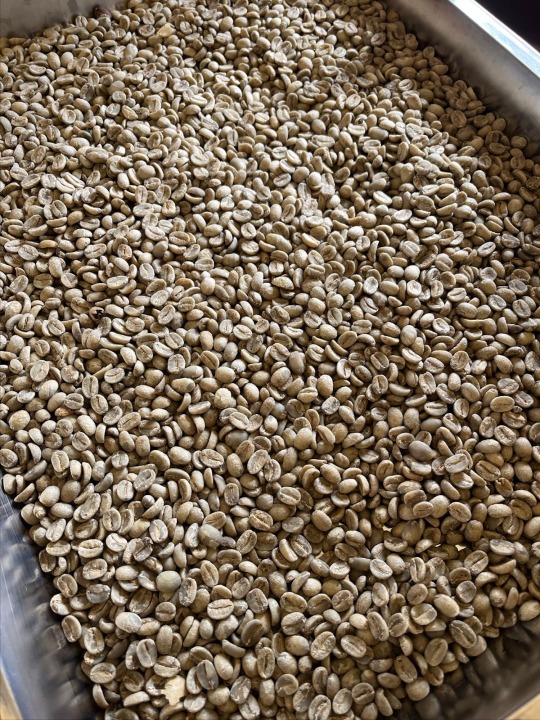
*乾燥して殻(パーチメント)を除いた豆はグリーンビーンズ(生豆)と呼ばれています。それらを焙煎してようやく馴染みのあるコーヒー豆の状態へと変わります!
My First Coffee Harvest Experience in Tadian
Hello everyone! I’m Kurumi.
A little time has passed, but today I’d like to share my experience helping with the coffee harvest on January 11 in Pandayan village, Tadian, about five hours from Baguio.
I’ve been gradually learning about coffee through CGN staff and my own research, but when I joined this harvest, I had almost zero knowledge about coffee, and everything was a surprise to me.
The experience started with my first real look at a coffee tree and its cherries. The task was to carefully pick only the ripe cherries while distinguishing them from overripe and unripe ones. To ensure new buds could grow the following year, we had to leave part of the stem intact—a delicate and precise process that required close attention.
The area we worked in was slightly sloped, which made it even more challenging. While I was carefully picking cherries, the people in Pandayan effortlessly harvested more than twice the amount I did. Seeing their physical endurance firsthand was truly humbling.
After the harvest, we returned to the barangay hall (village community center) and enjoyed a traditional meal called Pinikpikan, made with chicken and chayote. In the Philippines, people often eat with their hands, which can be tricky if you’re not used to it, as the rice tends to slip through your fingers. Initially, I struggled too, but thanks to my host family in Manila who taught me the technique, I was able to eat skillfully in Pandayan. Everyone complimented me, which made me really happy!
After a short break, we started sorting the harvested coffee cherries. Despite our careful picking, some unripe green cherries and insect-damaged ones were mixed in, so we had to remove them manually. The farmers also used a method called "floating," where the cherries are placed in water, and the hollow, lower-quality ones that float to the top are discarded.
Next, we moved on to extracting the beans from the cherries, which was also done entirely by hand. As shown in the photo below, we peeled off the outer skin one by one. It was an incredibly time-consuming task. My participation ended at this stage, but the process continues with drying and roasting. Before this experience, I never really thought about the effort behind every cup of coffee. Seeing how much time and labor go into each step, especially when done manually, gave me a whole new appreciation for it. From now on, I’ll cherish every cup I drink.
2 notes
·
View notes
Text
(English is below Japanese)
〜自己紹介〜
こんにちは、みなさん初めまして!2025年1月から3月までインターンさせていただくKurumiと申します。よろしくお願いします!

私は東京外国語大学言語文化学部フィリピン語専攻の3年生です。現在、1年間の休学中で、昨年8月から12月までフィリピン大学に留学し、今年1月からCGN��インターンをさせていただいています。
元々、英語以外の言語を学びたくて大学を受験した結果、偶然フィリピン語専攻になったのですが、今ではすっかりフィリピンの沼にハマり、留学するまでに至りました。この半年間の留学を経て、フィリピン語は日常会話には困らない程度まで習得できました。フィリピン人は英語を話せることが多いと一般的に思われているため、フィリピン語を話すと驚かれ、距離がぐっと縮まる気がします。もっと上達して、よりスムーズにコミュニケーションが取れるようにまだまだ頑張っていきます!

*マニラでホームステイしていた家から見た景色
また、私はフィリピンのレイテ島でインフラ整備を行うボランティア団体に所属しており、長期休暇の度に参加しています。初めて出会ったフィリピン人に「フィリピンのどこに行ったことがある?」と聞かれ、「レイテに4回行ったことがある」と答えると、たいてい驚かれます(笑)。観光地として有名な場所ではないので。

*レイテ島での道路舗装のボランティアの様子
CGNに応募したきっかけは、この学生団体で活動している中で、コミュニティとの深い関わり方や、より良いプロジェクトを作る方法について考えていたときに、大学の教授からCGNを紹介されたことです。コミュニティベースで活動するCGNで多くのことを学びたいと思い、インターンに応募しました。
マニラの喧騒とカオスな環境で5ヶ月過ごした後、バギオに来てその静けさに驚いていますが、3ヶ月という短い時間を充実させるために全力で駆け抜けていきたいと思います。そんな私がこのブログでインターンの活動を発信していきますので、ぜひ楽しみにしていてください!
2024年1月18日 Kurumi
Self-Introduction
Hello everyone! My name is Kurumi, and I will be interning at CGN from January to March 2025. It’s nice to meet you!
I’m a third-year student majoring in Philippine Studies at the Faculty of Languages and Cultures, Tokyo University of Foreign Studies. Currently, I’m on a one-year leave of absence from school. I studied at the University of the Philippines from August to December last year, and now I’m here interning at CGN.
I initially wanted to study a language other than English, and that’s how I ended up choosing this university. Becoming a Filipino major was a bit of a coincidence, but now I’ve fallen in love with the Philippines, which led to my decision to study there. After spending six months studying in the Philippines, I’m now able to comfortably engage in everyday conversations in Filipino. Filipinos are often expected to speak English, so they are always surprised when I speak Filipino, and it really helps me connect with them more easily. I still have a long way to go, but I’ll continue to study hard to improve my communication skills!
I’m also involved in a student organization that supports infrastructure projects in Leyte, Philippines, and I’ve participated in these projects during every long break. When Filipino friends ask me, “Where have you been in the Philippines?” and I tell them, “I’ve been to Leyte four times,” they are always surprised because it’s not a typical tourist destination like Cebu Island!
Through these experiences, I began thinking about how I can build deeper relationships with communities and how to create better projects. This led my professor to introduce me to CGN. I was drawn to CGN’s community-based approach, and I applied for the internship to learn more and contribute.
After living in the chaotic and noisy environment of Manila for five months, I’m now in Baguio, where the quietness has been a bit of a shock. With only three months here, I’m determined to make the most of my time and do my best. I’ll be sharing my internship experiences on this blog, so please stay tuned!Thank you for reading! Kurumi
3 notes
·
View notes
Text
Ifugao Trip
Magandang araw po!
6/11にIfugaoの伝統舞踊を見に行ったことについては書きましたが、現地で2泊して周辺の観光もしてきたので、それについて書こうと思います^^
伝統舞踊のパフォーマンスを見るために訪れたGotad Ad Festivalは、それらの出し物がある体育館の周辺に、飲食の屋台や、Ifugao州の各地域による屋外展示のコーナーもありました。

↑Asipulo Municipality(市)の展示の様子。中では、地元でとれた野菜や、伝統舞踊でも用いられていたRice Wineが販売されていました。
現地のガイドさんのお友達の家に泊まらせてもらえることになり、隣町のKianganまでトライシケルで1時間くらいかけて向かいました。
ガイドさんがマーケットで鶏をまるまる一羽買ってきて、家の外でさばいて煮込んだものをごちそうしてくれました。生きた鶏を食べられる状態にする過程を初めて目の当たりにし、目を背けたいような衝撃的な場面もありました。Ifugaoの先祖代々の伝統で、お祝い事などの際にはまるまる一羽の鶏をみんなで食べることがあり、生き物へのリスペクトをもってさばくとのことで、他者の命をいただくということについて考えさせられるいい経験になりました。肉とそのだしが染みたスープをお米と一緒にいただき、とてもおいしかったです!次の日の朝まで大切に頂きました。
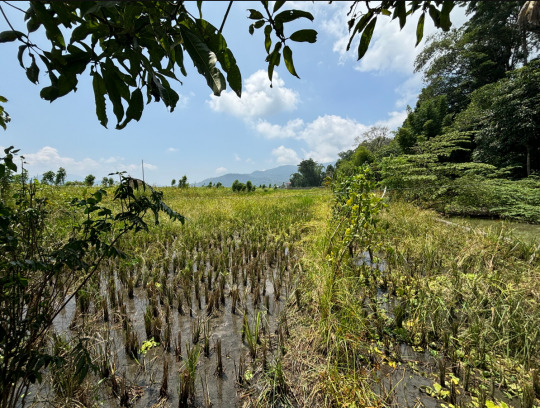
↑次の日の朝。稲作が盛んなIfugaoらしく、家の周りには田んぼが広がっていました!周辺を散策して気持ちのいい朝でした🌤
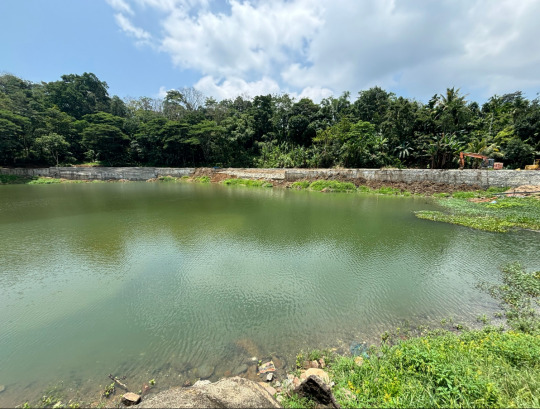
↑この日はKianganを案内してもらいました。これはAmbuwayaという湖。
次はKiangan Shrineに行きました。Kianganは、第二次世界大戦で第14方面軍司令官だった山下奉文大将が投降した町であり、Kiangan Shrineの敷地内には、山下大将に関する博物館と、Ifugaoの先住民族の文化について知ることができる博物館があり、写真は撮れませんでしたが、どちらも見学しました。
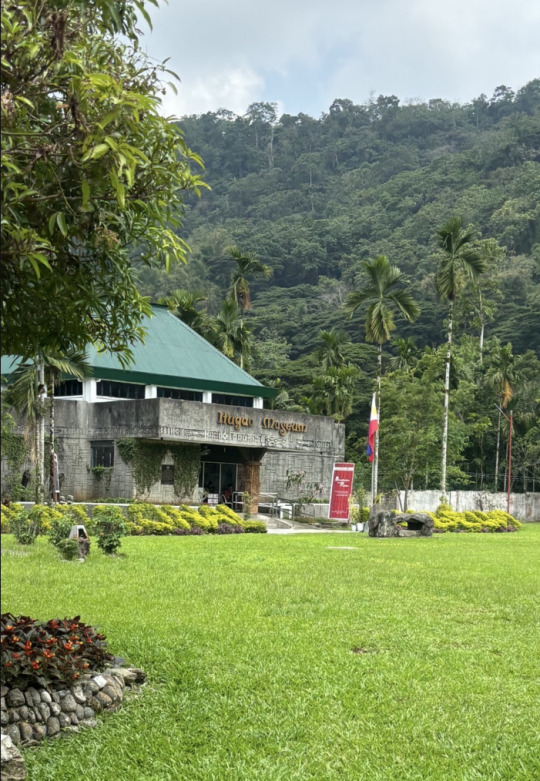
イフガオ博物館には、主にイフガオの地域ごとに異なる織物についての展示が多くありました。地域ごとに模様も違えば織り方も異なっており、織物に使う糸を綿花から作るところを少しだけ体験しましたが難しかったです^^;;
この後夕方5時のバンに乗ってバギオに帰る予定だったのですが、トライシケルやバスを乗り継いで、バギオへのバンのターミナルがあるバナウェについたのは5時半、バンは既に出発してしまっており、頼みの綱だった高速バスもなぜかスケジュールを変更しており今日はもうないとのこと、、、。
しかしガイドさんの別のお友達が家に泊めてくれるとのことですぐに向かうことになったのですが、お家はAsipuloというイフガオの中でもバナウェからはかなり離れた地域にあり、今来た道をまたKianganまで戻ってからトライシケルに乗っていくとのこと、、(笑)
Kianganまでとんぼ返りし、そこからまたトライシケルで1時間くらいかけてAsipuloに辿り着き、お家に1泊させていただきました。お友達とそのご両親がいらっしゃったのですが、皆本当にやさしく、次の日の朝も、またおいでね!といって送り出してくれました。
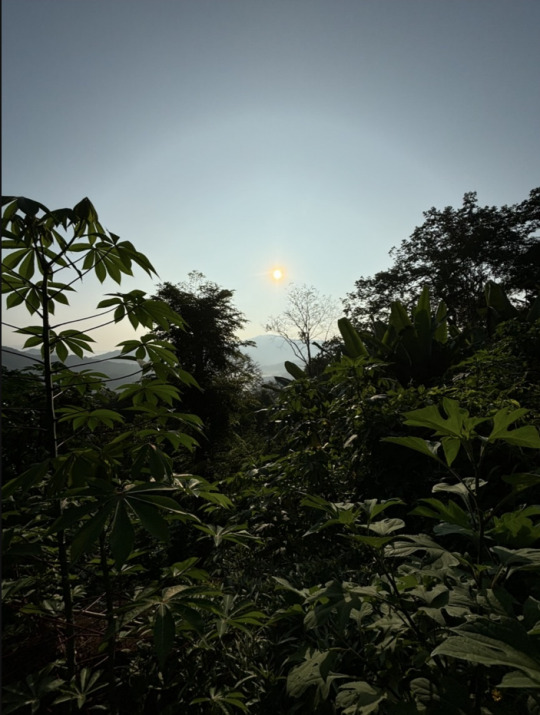
↑Asipuloのお家の外から見た、朝6時半の朝日。
かなりの波乱万丈旅でしたが、思わぬハプニングと出会いにより、IfugaoのMunicipalityを4つも訪れることができ、終わってみればとてもいい経験でした(笑)
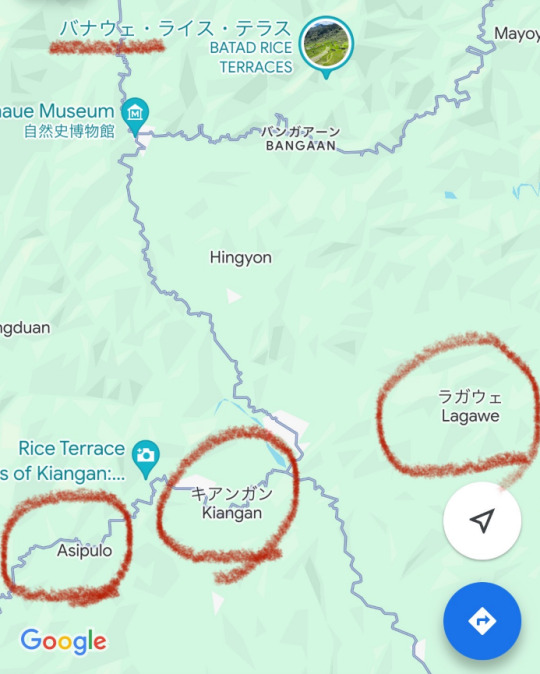
↑私が訪問した地域。次はライステラスにも行きたい、、、!
Ifugao Trip
Hello!
I mentioned in the last article that I’ve been to Ifugao to see the traditional dance on June 11th. I stayed there 2 days and went around there so I’m going to talk about that!
Gotad Ad Festival has not only dance performances but also street food or exhibitions outside.
Each exhibition expresses their own character of their municipalities. I entered that of Asipulo. They were selling some vegetables and rice wine from there.
One of my guide's friends invited us to stay at her home and we went to her home in Kiangan municipality. It took about 1 hour to go there from Lagawe by tricycle.
My guide bought a live chicken from the market and cooked it for us. I was surprised because it was my first time to see cooking a live chicken.I heard that in ancient times, they also cooked chicken at a feast in Ifugao. They cook chicken with a lot of respect to their lives. Although at first I was surprised, it was a good experience for me to think about taking the other’s life for our meal. We had chicken that night and the next morning, it was so delicious!
Next morning, I walked around there and saw rice fields. I felt very good to breathe in the fresh air in Kiangan!
My guide’s friends took me to some places in Kiangan. I saw Ambuwayan Lake.
After that we went to Kiangan shrine. Kiangan is a place that General Yamashita had given in to in WW2. There is a museum that explains and exhibits pictures about what he did there. There is also an Ifugao museum that has textiles of each municipality in Ifugao. I had experienced how to make stitches from cotton.
I was planning to go back to Baguio by ban leaving Banaue at 5PM. However we got to Banaue at 5:30 and every way that I can go back has left. Then the other friend of my guide invited us to stay at her home. But her home is located in Asipulo municipality, so we went there by bus and tricycle and it took about 2 hours!
We arrived and my guide’s friend and her parents welcomed us. They are so kind to tell me “Balik ka!”(Come back again). I saw a beautiful sunrise in the early morning, before I left.
I had some accidents but there was a good meeting with my new friends in Ifugao. In addition, I could visit 4 municipalities in only 2 days!! I hope I can visit rice terraces next time:)
0 notes
Text
Ifugao
Magangdang umaga po!
卒論に向けての研究の第一歩として、6/11にイフガオ州ラガウェで行われた、Gotad Adというお祭りを見に行きました!
会場であるラガウェは、私が研究するDinuy-aという伝統舞踊の発祥の地であり、イフガオ州の中心部に当たるバナウェからジープでさらに1時間ほど南下します。
メイン会場のDon Bosco高校の体育館では、6月1日から18日まで、踊りの他にも芸術作品の展示やバイクレースなど様々な催しが行われており、その周辺には出店や屋外展示などがたくさん並んでいてとても活気がありました!

伝統舞踊のパフォーマンスの様子。
この踊りはラガウェで始まりイフガオ州に広まったため、同じ踊りでも州内の地域によって表現方法が微妙に違っているそうです。私の地元・徳島には阿波踊りがあるので、同じ阿波踊りでも連によって踊り方や構成が違うのと似ているなあと思いました^^
今回の催しはコンペティション形式で、それぞれのグループは地域を代表しており、画面中央右に写っている審査員が最も優れた演技を決定するそう。アリーナを囲むように椅子に座っているのは出番に向けて待機している他の地域の踊り子です。

最も印象に残ったのは、鶏を使った踊り、、
手を話すと鶏が飛んで行ったり、生き物を使った踊りが私には衝撃的でした...!
今回は突然決まった訪問だったので長く滞在することができず、世界遺産の棚田すら見ないで帰ってきてしまいました💦
私を連れてきてくれたガイドさんのお友達をつたって、祭りがあったところとは少し離れた地域に泊まり、現地の生活を���感する貴重な経験もできたので、それについても機会があれば書こうと思います!
次の訪問は今回できたつながりを頼りにもう少し長く滞在する予定なので、舞踊についてももう少し詳しく知ることができればいいなと思います!!
Ifugao
Hello!
I went to Lagawe municipality, Ifugao province on 11th June and saw the festival there!
That was my first step for my research about the traditional dance in Ifugao.
Lagawe is the municipality where the Dinuy-a dance was born. It takes about 1 hour by jeepney from Banaue, which is the center of Ifugao, to go there.
There were also exhibitions of arts and bike races and so on at the gym of Don Bosco High School. And then outside, they have lots of street foods or exhibitions that express characters of each municipality in Ifugao.
I’ve mainly seen dance performances held there.
Dinuy-a dance was born in Lagawe and then spreaded among Ifugao, so these are a bit different depending on the municipality. My home town Tokushima also has their own traditional dance named Awaodori, each group also has different ways of dance. I ‘ve been thinking there are similarities.
This event is a competition and each group is on behalf of their own municipality. There are judges in front of dancers and dancers from other municipalities are sitting around and watching them.
The most impressive thing is that some of them are holding chicken during the dance and sometimes they are flying! It was surprising for me to use a living creature in their performance!
I couldn’t stay long and even see rice terraces which is their signature. Guide accompanied me and I stayed at his friend's house located in Kiangan and Asipulo. I’m happy to experience the lifestyle of a provincial city and I hope I will be able to write about that sometime.
Next time I will stay there more long so I will proceed my research more:))
0 notes
Text
Tam-awan village
Magangdang araw po!
卒論研究で伝統舞踊を扱おうと思っているので、その材料探しと観光を兼ねて、Tam-awan villageに行ってきました!
住んでいるところから意外と近く、ジープに乗って20分くらいで着きました^^

入場料は1人60ペソ(約162円)。安い^^

名前の通り施設全体が一つの村のようになっていて、コルディリエラ地区のそれぞれの民族の伝統家屋が並んでいます。
上の写真はAlangといって、Bontocという民族の米の貯蔵庫だそうです。中にいるのはBul-ulという、米の守り神とのこと。

施設内にあるカフェで、カラマンシージュースを飲みながら休憩していると、伝統舞踊のパフォーマンスを見ることができました!

これはBugnayというKalinga民族の伝統家屋で、中に入ることができます。中には現代アート作品が飾ってありました。この家屋は建設した後、住む人の健康と繁栄を祈るために、家のいたるところに豚の血をかけるそう、、!
観光地なので、もちろん観光に特化した施設ではありますが、新しい学びもあって楽しい訪問でした!!^^
Tam-awan village
Hello!
I’m going to study about the traditional dance in Ifugao, so I went to Tam-awan village to collect information and sightseeing:)
It’s close to my house and takes only 20 minutes by jeep!
Admission fee there is 60 pesos. How cheap it is! 🙂
There are many traditional houses of each area in Cordillera and it looks like one village in total.
The second picture shows the house of Bontoc named Alang, their rice granary. The objects inside is Bul-uls, the guardian of the harvest.
While I was drinking calamansi juice and taking a rest at a cafe, the performance of traditional dance started! I could watch them and it’s worth seeing.
There are also traditional house of Kalinga named Bugnay. You can enter inside. Many contemporary arts are shown there. After it’s constructed, the priestess chants and sprinkles the blood of a pig on various parts of the house!
My visit was so enjoyable and there was a lot of new information that I wanted!:)
0 notes
Text
アンコール・ワット
Magandang araw po!
またまたCGNに関係ない内容で恐縮ですが、、
5/15-23と一週間超をかけてアンコールワットを見に行ってきました!!
もともと世界遺産や世界史が好きで、アンコールワットは人生で一度は見ておきたいと思っていたので、スケジュールに余裕がある今のうちに訪問しておこうと思い立ちました✨
バギオから空港があるマニラまでもバスで5時間くらいかかるので、渡航の前後でマニラで宿泊しました。フィリピンから(日本からでも)カンボジアへの直行便はなく、マレーシアかバンコク(他にも選択肢はあるのかもしれませんが)で乗り換える必要があります。せっかくならマレーシアにも行ってみたいと思い、マレーシアにも宿泊して1日だけ遊びました、!というわけで全日程に1週間以上かかってしまい帰ってくる頃にはかなり旅疲れしていました^^;
アンコール・ワットとは
ヒンドゥー教寺院アンコール・ワットと都城跡のアンコール・トムに代表される『アンコールの遺跡群』は、クメール人の王朝であるアンコール朝の都市遺跡である。879年、この地はアンコール最古の寺院プリア・コーのヒンドゥー教寺院が建立された後に王都となり、歴代の王が都城と寺院を次々と造営していった。
(『きほんを学ぶ世界遺産100 世界遺産検定3級公式テキスト』 p.92)
それぞれの遺跡は車で20分くらいの少し離れた距離にあるので、ホテルでトゥクトゥクなどの交通手段を手配できることが多いようです。私も、アンコール・ワットと、バイヨン寺院を中心とした都市遺跡であるアンコール・トム、巨木の根に浸食された寺院が有名なタ・プロームの3つを周るトゥクトゥクをホテルで手配しました!

↑バイクの後ろに座席が付いたトゥクトゥクで森の中を走ります。一度ジャングルの中に埋もれてしまった遺跡を、19世紀にフランス人博物学者が発見したらしく、このジャングルの中からよく見つけたよなあ、、など考えながら乗っていました^^

↑トゥクトゥクを降りたら暑くて干からびそうでした🥵

↑とにかく広い!!参道は約600mあるのですが、暑さがかなりこたえます

↑やっとご対面!すでに汗だく(笑)
世界史の教科書の中に入り込んだような荘厳な雰囲気、、!

↑中に入ることができます。ここは十字回廊と呼ばれる部分で、天井や柱に当時の彩色を残しています。

↑裏から階段を上って中に入ることもできます。

↑階段を上ると、��こまで歩いてきた参道とアンコールワットの全体が見渡せます。1000年以上前に、ここに王国があったんだなあ、、とタイムスリップの気分に浸っていました^^;

↑遺跡の周りは環濠(堀)で囲まれていて、これは地球に存在する無限の大洋を表しているのだそう。
ほかにも、

↑アンコール・トムと、

↑タ・プローム寺院の巨木も見学しました。
付近にはアンコール朝時代を含むカンボジアの歴史を学ぶことができる博物館もあり、そちらも見ごたえ十分でした。(写真は撮れなかった^^;)
道中大変なことはたくさんありましたが、本当に行ってよかったと思います!!
Trip to Angkor Wat
Hello!
I had a trip to Angkor Wat from May 15th to 23th!
I have longed to visit there because I’m interested in the World Heritage and learning History of them. It was on my bucket list (^^)
It takes 5 hours to go to Ninoy Aquino International Airport in Manila, so firstly I stayed in Manila. We have to transit in Malaysia or Thailand to go to Cambodia because there is no direct flight from the Philippines (even from Japan) there. I also wanted to visit Malaysia not just by transit but as sightseeing, so I stayed there and went around there for only 1 day. It took 1 week to complete everything and I was really tired when I came back^^;
What is Angkor Wat?
The ``Angkor ruins,'' represented by the Hindu temple Angkor Wat and the ruins of Angkor Thom, are the city ruins of the Angkor Dynasty, a Khmer dynasty. In 879, this area became the royal capital after the construction of Angkor's oldest Hindu temple, Preah Koh, and successive kings built forts and temples one after another.
(“Learn the Basics of 100 World Heritage Sites: World Heritage Certification Grade 3 Official Text” p.92)
You should order tuk tuk at your hotel because the ruins are far from each other. I also ordered tuk tuk goes to Angkor Wat, Angkor Thom and Ta Prohm.
Tuk tuk goes into the jungle where the Angkor wat is located. Angkor Wat had once been left in a jungle and forgotten, but the French naturalist found it in the 19th century. While I was taking it, I wondered how hard it was to find it.
After I took off from tuk tuk, I had to walk 600m toward Angkor Wat. It was super hot!!!!🥵
When I finally saw it, I was already sweating a lot…! I felt like I was in a text book of world history.
If you enter there, you can see a cross corridor. Its ceiling and pillar look like how it was 1000 years ago. Also you can enter from the stairs and see around the whole of Angkor Wat. I was imagining there was a kingdom where I was standing.
The moat around Angkor Wat represents the infinity of the sea on earth.
I have been able to visit Angkor Thom and Ta Prohm.
There was a great museum and you can learn about Kmer history including the Angkor dynasty.
Sometimes it was hard to travel abroad but it was a great memory for me:)
1 note
·
View note
Text
Vigan旅行🚌
Magangdang araw po!
5/11-12日と2日間お休みを頂いたので、ずっと行きたかったVigan Cityに行ってきました!!
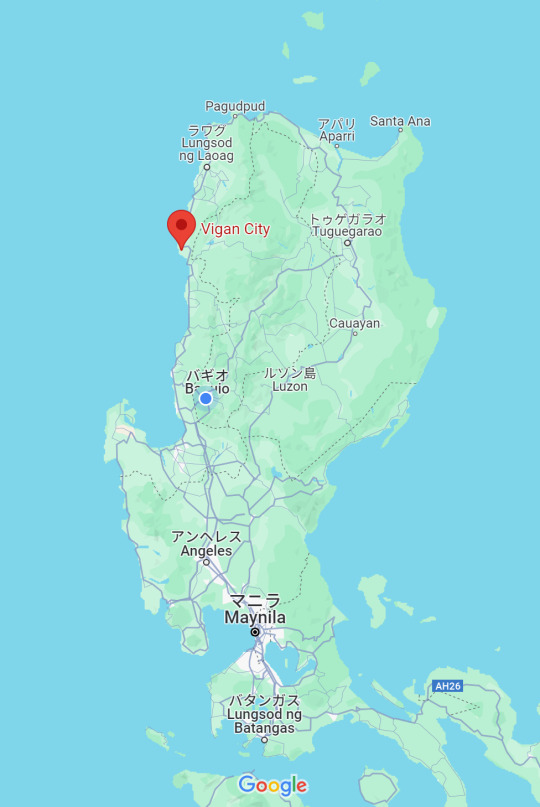
赤いピンが立っているところがVigan Cityです。
地図で見ると、マニラ・バギオ間より近そうだしすぐ着くでしょ^^と思ってたけど、途中で何回も止まって人を乗せたり降ろしたりするし、高速道路でもなさそうな道を行くので結局片道6時間くらいかかりました^^;そもそも長距離バスをタクシーみたいに止めて途中乗車できるのも衝撃でした、!
Vigan City
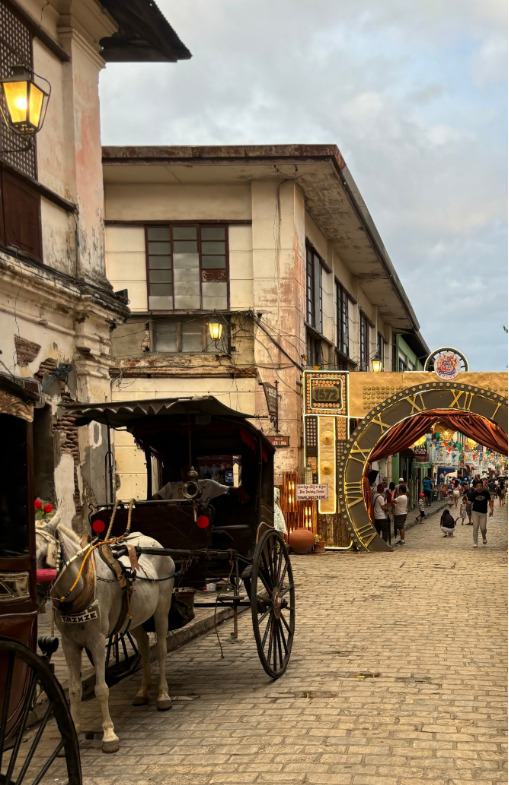
スペイン植民地時代の街並みを現在まで残し、1999年に都市全体が世界遺産に登録された歴史ある街です。ずーっと行きたいと思っていたのですが、ほぼ北の端っこにあるのでどうやって行くのかもよくわからずあきらめかけていました、、が、バギオに住むことになりバスで行けることが分かったので念願の旅行が実現しました(^^)
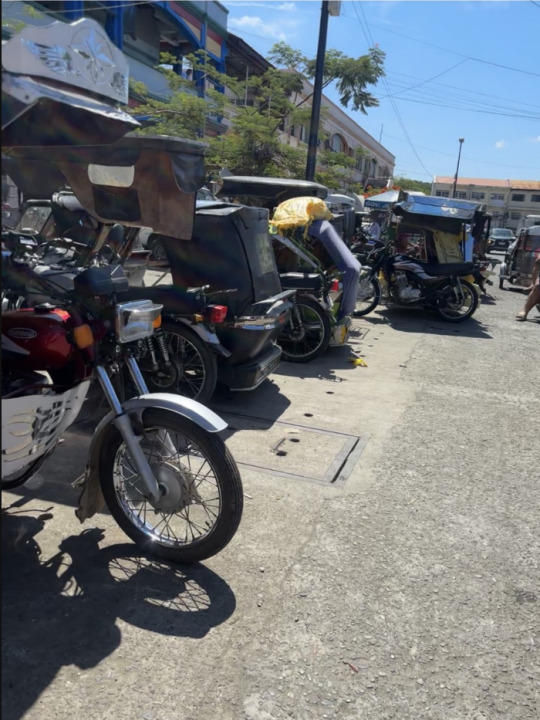
現地での細かい移動は、トライシケルと呼ばれる、モーターバイクの横に座席が付いた小さい乗り物をつかまえます。バスを降りたらすぐにトライシケル運転手のおじさんに話しかけられ、一瞬混乱しましたがホテルの名前を伝えると連れて行ってもらえました。5分ほど乗って40ペソ(約109円)。
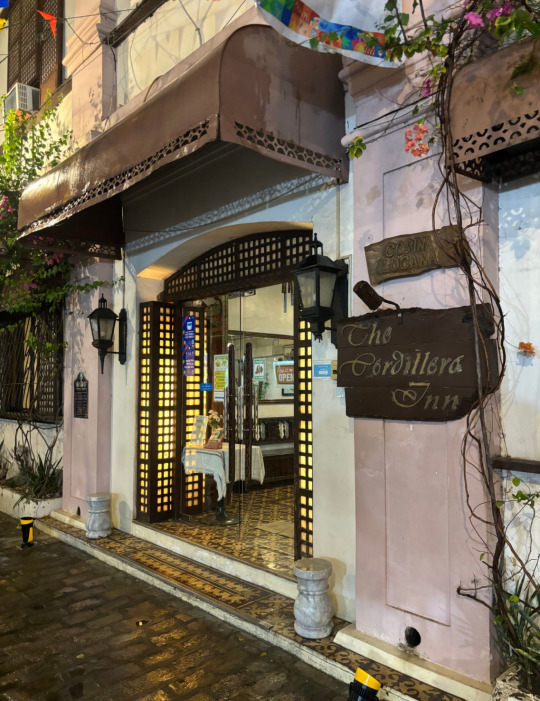
泊まったホテル!
Vigan観光のメインである石畳のCrisologo Streetのど真ん中にあり、内観もアンティーク家具がたくさんできれいでした!!
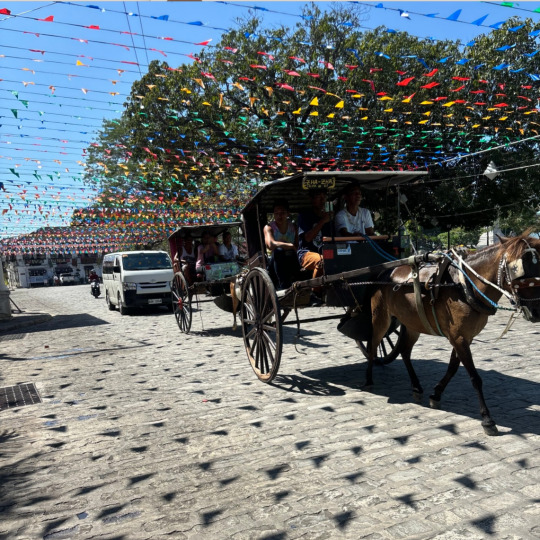
街のいたるところをKalesaと呼ばれる馬車が走っており、歴史的なスポットを案内して回ってくれます。ホテルを出てすぐに何度も誘われ、値段を聞くと30分くらいで200ペソ(約543円)。いい経験かなと思って乗ってみました^^
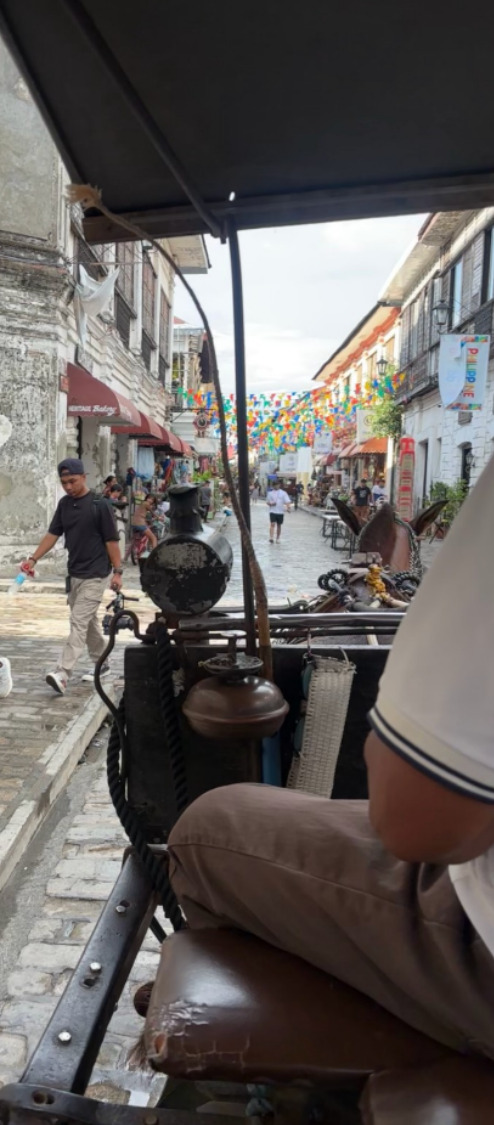
お馬さんがんばれ~~🐎
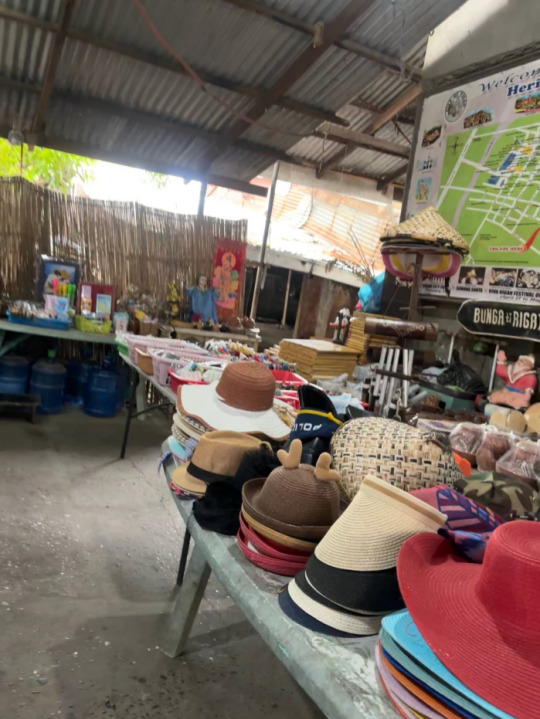
本当は博物館などいろんなところに寄ってもらえるようですが、夕方17時を過ぎていたのでどこもしまっていて、このマーケット��だけ寄りました。帽子や置物など観光客向けのお土産物がたくさん置いてあります。
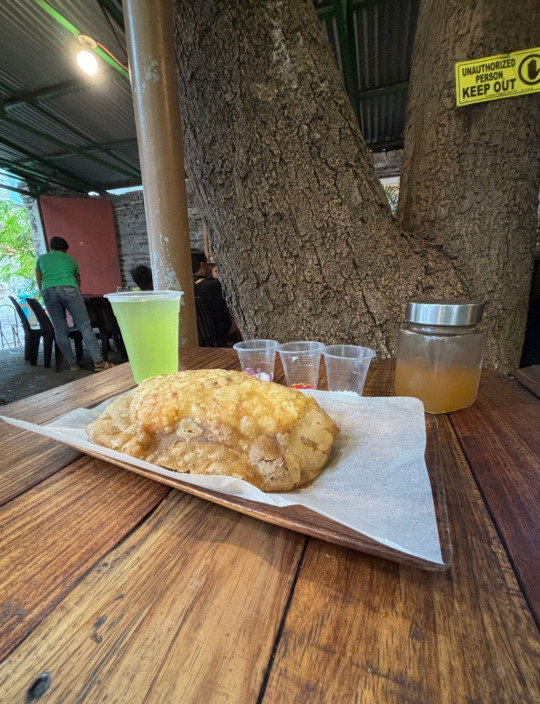
晩ご飯は、観光客に大人気だというお店でEmpanadaをいただきました♡
Empanadaは、ルソン島北部の名物料理で、ひき肉や玉ねぎなどを炒めたものをパリパリの皮で包んであげたもの。Baguioに住んでいる人が、Empanadaは「完璧な料理」(野菜、肉が同時に食べられるから)だと言っていたのを思い出しました^^
奥に見えている飲み物は、Cucumber Lemonade。名前の通り、きゅうりとレモンの味が一緒くたになっていました、、、!Vigan City のいたるところで売られていました。
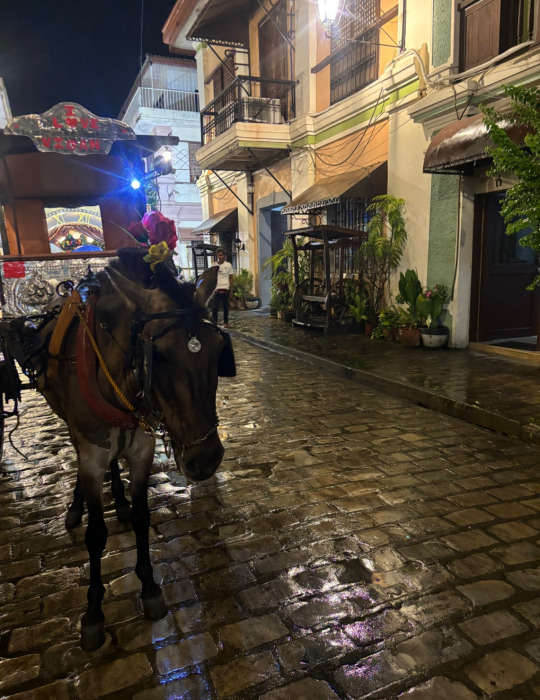
夜もきれい~✨
2日目は、早起きして博物館に向かいました。
ビガンは織物産業で有名らしく、機織りの道具がたくさん展示されていました。
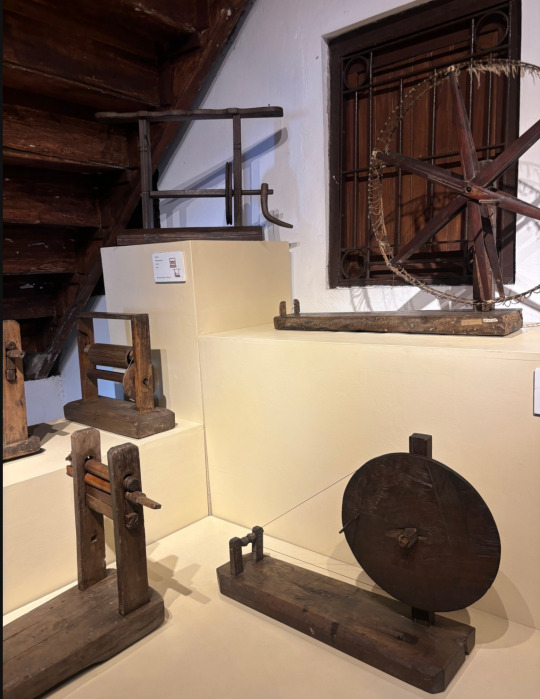
とてもこじんまりとした博物館で、15分もあれば全部見終わってしまいました。
到着したのが夕方だったので1日目はそこまで感じませんでしたが、2日目は天気がすこぶる良くとにかく暑い!!!🥵フィリピンに来た次の日からバギオにいたのであまり実感できていませんでしたが、やっぱりバギオは快適なんだなと思いました(笑)
せっかく長期滞在するのでフィリピン中のいろんなところを訪れたい、、しかしバギオの涼しさから抜け出せなさそうな気がしています...(笑)
Vigan Trip
Hello!
I have been to Vigan for two days 5/11~12 because it was my day off:)
I thought Vigan is close to Baguio but it took almost 6 hours because our bus went on the general road, not a highway!! I was surprised that the bus can stop for every passenger who is waiting for us on the road, like a taxi!
About Vigan City
Vigan is a historical city that was registered on the world heritage list in 1999 because of their cityscape that is lasting how it was in the period of Spanish rule. I have longed to go there but I didn’t know how to go. I have started to live in Baguio and I know I can get there by bus, so I decided to go there!:)☆
My journey☆彡
You can catch a tricycle to go around Vigan. The drivers were waiting for the passengers at the bus terminal, and one of them talked to me. I was a little confused because it was my first time taking it, but he took me to the hotel. It took 5 minutes and cost 40 pesos.
My hotel was located on the center of Crisologo Street which is the main spot of sightseeing. Their antique interior was beautiful!!♡
You can also ride on the Kalesa. It goes around historical spots in Vigan City. The drivers asked me many times if I would ride on, finally I said yes because it would be a nice experience:) Usually you can get off at all of the historical spots like museums, but I could not because they were already closed. I could get off only at the market that was selling handicraft products or objects for the tourists.
I had Empanada for dinner at a restaurant that is popular with tourists.Empanada is famous in Ilocos, that is wrapped fried minced meat,onions and something else, with crispy skins. Once some people who live in Baguio said that Empanada is a perfect meal, that includes all of the stuff(like meat and vegetables),,,;;And I also drinked Cucumber Lemonade for the first time! It really tasted like cucumber and lemon,,,!! They were sold around the city.
On the second day, I woke up early and went to the museum. There were many old machines for weaving machines because it’s an important industry in Vigan. The museum is very small, so it took only 15 minutes to see all of them.
On the first day I didn’t feel it but the second day is too hot, especially in the morning🥵I understood how comfortable Baguio is (^^) I would like to visit many city around the Philippines but I might not be able to get out from comfortable Baguio^^💦
0 notes
Text
コーヒーゼリー
Magandang araw po!
今日は、私のインターン生としての初めてのプロジェクトである、コーヒー店の新メニューのコーヒーゼリーのメニュー開発の過程を書こうと思います。
そもそも、コーヒーゼリーといえば、日本の喫茶店やファミレスなどによくある

こういうもの、ゼリー単体のものを私は思い浮かべていたのですが、
フィリピンでは、

こんな感じで、クリームがいっぱい入ったものが主流だそう!
まずは、日本でよく使っている料理のレシピのアプリで、いちばん簡単そうで余計に手が込んでいないコーヒーゼリーの作り方を探して、そのままマネして作ってみました。お菓子作りすらほとんどしたことがなく、さらにフィリピンのスーパーマーケットにもまだ慣れていないので、材料を探し出すのすら大変でした^^;

こんな感じ。
、、、初めてにしては上出来やん??^^
2枚目の写真のビジュアルを想像していたのですが、コーヒーゼリーの粒が大きく、クリームが上部に留まる形になり、これで大丈夫かな?と思いましたが、
店のオーナーさんに見せてみると、
いいじゃん!^^
と。2回目からさっそく味見をしてみることになりました。
ところが問題発生!
1回目は練習用にインスタントコーヒーで作ったのですが、お店で挽いた豆をそのままインスタントコーヒーみたいに使って作ると、コーヒーが溶け切らずに底に残ってしまう、、(考えてみたらそりゃそうだけど^^;)
アルバイトさんのアイデアで、お店で作っておいてあるcold brew(水出しコーヒー)で作ってみることに。挽いた豆で作ったものとcold brewで作ったものを、お店のみんなで味見して比べてみました。
すると、豆が残ってしまうのは良くないけど、コーヒーの味はcold brewよりもよくでている、ということになり、、
同じ豆を、cold brewでなく通常通りお湯で抽出したコーヒーでもう一度作ってみました。

見た目はあんまり変わってないけど^^
味は大成長!!!
現在も砂糖の量など微調整中です^^
お客さんに出せる日がくるといいな✨
Coffee Jelly
Hello,
Today’s topic is about my first project as an internship student, producing a new menu coffee jelly!
At first, I imagined coffee jelly with no cream, but I heard that Filipino people are familiar with coffee jelly with full cream…!
However, first I looked for the most simple recipe of coffee jelly written in Japanese on the Internet. I’ve almost never made my own snacks and it’s difficult to look for the ingredients because I’m not used to the supermarkets here in the Philippines …;)
But the first thing I made was better than I thought…!^^
It looks a little different from what I thought, but the next time I used coffee beans from the shop, nest coffee roasters.
But the accident happened,
The grinded blend coffee beans that could not be dissolved were left in the bottom of the jelly(that’s natural thing though…;;) We compared that one and one made by cold brew coffee.
As a result, the one made by blend coffee is better in its taste, while dissolved beans are not good,,,
Next, I tried to make it by pourover of blend coffee.
Then, it looks not so different but very improved in its taste…!!
I’m still adjusting the amount of sugar, gelatin powder or something…^^
I’m looking forward to the days when I can serve it to the customers!!!♡
0 notes
Text
バギオについて
バギオに住み始めて2週間が経ちました。私は徳島県で生まれ、大学に入学してから3年間大阪で一人暮らししていたので、私の居住経験は徳島→大阪→バギオということになります。文化的なギャップという意味でのとんでもないジャンプアップに自分でも驚いています^^;
今日は、バギオに住み始めてみて感じたことを書き残しておこうと思います。帰るころには当たり前になって何も感じなくなるかもしれないので^^
治安
海外に住むぞ!と決めて、いちばん気になることの一つが”治安”だと思います。渡航前、もちろん私自身も気になって「バギオ 治安」で検索しましたし、身近な人からも「フィリピンって治安悪いんじゃないの?」と心配されることがよくありました。
バギオに住んでみると、バギオの安全さはいたるところで感じられます。
CCTVと呼ばれる監視カメラが町中を見張っており、ショッピングモールやスーパーマーケットに入店するときには飛行機の���乗の時のように持ち物を検査されます。人から見えるところで、公的に人々を守ってくれているという安心感が感じられました。タクシーもおつりはちゃんと返ってくるし、日本に比べるとかなり安いのでとてもありがたいです!
私はコンドミニアムと呼ばれる家具付きのアパートのようなところで一人暮らしをしているのですが、家のオーナーさんに、
「家の中の空気を新鮮にするために、お出かけするときは家の窓を開けていくといいよ!」と言われたのはかなり衝撃でした、、、!
油断していいわけではないと思うので、引き続き自分で身を守る行動を心がけようと思います^^
味付け
フィリピン料理は甘い!!
私は日本の大学でフィリピンについて学んでいたので、フィリピン料理が何もかも甘いということは聞いたことがありました。フィリピンに住む前は、「毎日辛いものばっかりは大変だけど、甘いのは余裕でしょ^^」と考えていました…
ケーキやキャンディなどが甘いのは問題ない(それも日本より甘い!)のですが、チキンにかかっているソース、ファストフード店のパスタやポテトなど、日本ではしょっぱいものが好まれるものが、甘かったり甘酸っぱかったりするのはかなりのカルチャーショックでした...!
家のオーナーさんと食事に行ったとき、
しょっぱい麺料理の横に山盛りのカラマンシー(フィリピンのすだちのようなもの)が置いてあり、みんなそれをかけながら食べていたので、
「フィリピン料理って酸っぱいものと甘いものが多いけど、しょっぱいのは嫌いなのかな?」と聞くと、
しょっぱいのは苦手だから、カラマンシーをかけてしょっぱさを和らげているとのことでした。
考えたこともなかったですが、日本のファストフードのポテトはこれでもかというほどしょっぱいし、日本人が大好きなラーメンもしょっぱい、、日本人はしょっぱいものが好きなのでしょうか^^
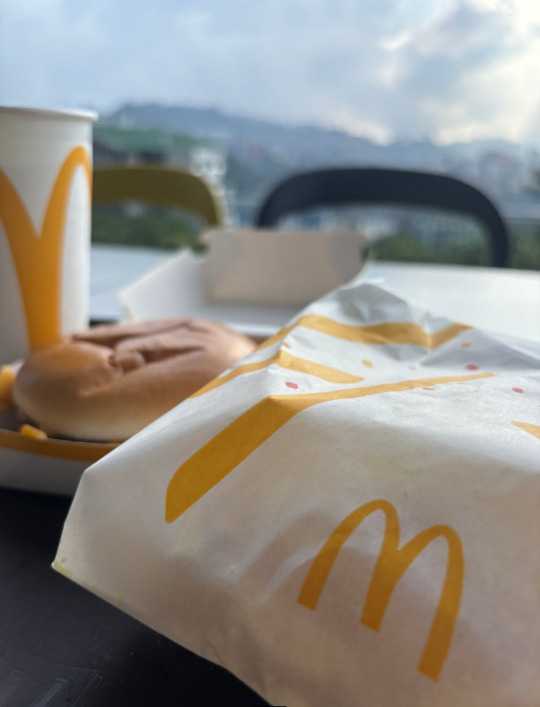
↑コーン味のパウダーを袋に入ったポテトにかけて振って食べる。
余談ですが、SMモール(日本のイオンモールのようなショッピングセンター)の外側にあるレストランでは、外の席でバギオの美しい景色を眺めながら食事することができます✨
思うことはいろいろありますが、景色がきれいで、人もフレンドリーなバギオがとても気に入っています!観光地であるものの外国人の観光客は少ない(フィリピン人観光客が多い)ように感じるので、日本人にもバギオ観光が広まればいいなと思います^^
Baguio
It has been two weeks since I have started living in Baguio. Baguio is nevertheless my first city to live abroad:)
Today, I’m going to talk about my first impression to Baguio, as soon as it is a fresh feeling for me^^
Safety
Before I came here, the biggest concern was “safety”. However, it can be said that Baguio is a safe place, in a sense.
For example, CCTV cameras are monitoring around the city. When you are going to enter shopping malls or supermarkets, your baggage will be checked like check-in of the aircraft. If you don’t have exact money for the taxi fee, you don’t have to worry because the change will come back correctly. I felt relieved about the security here for the past two weeks.
I was so shocked when my house owner told me that
“You should open the windows of your room so that fresh air can come in!”...!!
I have to be careful to protect myself even if Baguio is a safe and nice city:)
Taste
First of all, Filipino food is sweet!!
I have learned in my Japanese uni that Filipino food is sweet, but I’ve thought
“I can still live there easily because I like sweets very much:)”
But the biggest problem is everyday meals, not desserts,,,!
Chicken, spaghetti, and even french fries are sweet, here in Baguio!
When I went to have lunch with my house owner, I found everyone squeezing the caramansies on their meal, and I asked her whether Filipino people don’t like salty food.
She said “Yes, I’m not good at salty food and that’s why I use caramansies to relieve the saltiness of the meal!”
In conclusion, I already like Baguio! Most people here are very friendly, and it has great scenery✨ I want to spread the goodness of Baguio to people in Japan:)♬
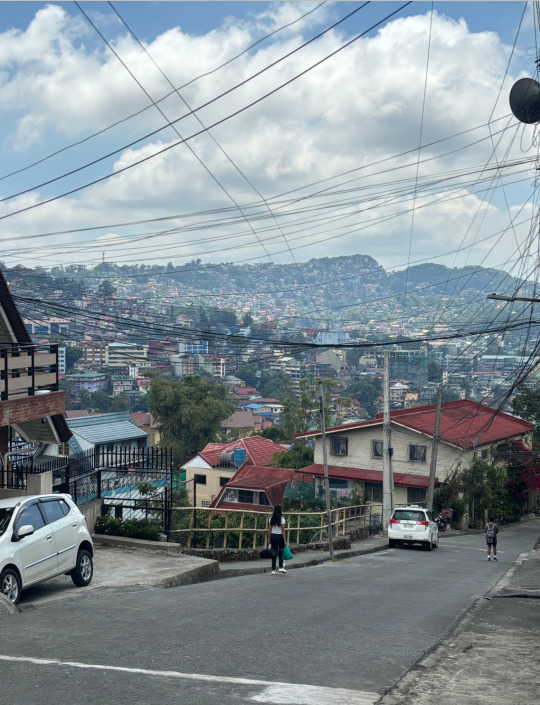
↑Great view from Aurora Hill, Baguio
0 notes
Text
🌟自己紹介🌟
初めまして!
2024年4月~12月(終了時期未定(^^;)、CGNでインターンをさせていただく、Haruna と申します。よろしくお願いします😊
まずは自分のことについて書きたいと思います(*^^*)

大学
大阪大学外国語学部外国語学科フィリピン語専攻の3年生です。今は大学を1年休学し、バギオに滞在しています。
なぜフィリピン語専攻を選んだの?と、大学に入学してからほぼ毎日といえるほど聞かれるのですが、、(^^;
小学生の頃から英語を勉強していましたが、英語を話せる人なんて今時いくらでもいるよなあというところから何か人と違う自分の武器が欲しい、誰もやってないことをしてみたい!という考えに至り、外国語学部に興味を持ちました。
そのなかでもフィリピン語を選んだ理由は、
・将来観光業に就きたいので、日本人がよく観光に行くところ
・治安がよさそう
・アルファベットだから新しく文字を覚える必要がない
・原住民とスペイン、アメリカ統治時代のものが共存している独自の文化
・高校の英語の先生がフィリピン人だったため身近に感じられた
などたくさんありますが、外国語学部の専攻紹介のパンフレットにセブ島留学の体験記があり、きれいなビーチでココナッツジュースを飲んでいる写真に惹かれたのが決め手でした(笑)結局今はセブ島とは遠く離れたバギオに滞在していますが(^^;
フィリピン語力はまだまだ発展途上であり、日々言語習得の難しさを痛感しています(-_-;)
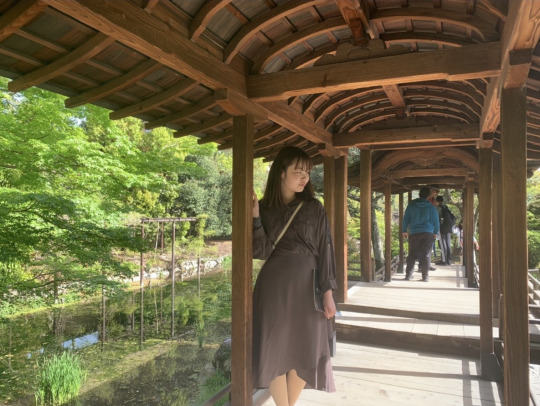
CGNに辿り着いた経緯
せっかくフィリピン語を勉強するなら在学中にフィリピンに長期滞在したいとはかねてから考えていましたが、さらにせっかく滞在するなら大学に通うだけじゃなくてなにか成し遂げたい、フィリピンの人々に還元できる活動をしたいと思い、日本人がフィリピンで活動している、インターンを募集している団体をインターネットで探したところ、CGNに出会いました。とはいえ具体的にやりたいことが決まっているわけではなかったので、幅広い活動に取り組んでいるインターン生のブログを見て魅力的に感じ、直接連絡させていただきました...!
好きなこと
ダンス
大学ではストリートダンスサークルに所属し、ロックダンスを練習しています!ある年代以上の人には、SMAPの中居くんがやってるダンスといえば通じるそうです(^^)
歌うこと♬
小学校高学年から高校生まで合唱部に所属しており、歌うことが大好きです(^^♪渡航してまだ1週間と少しですが、すでに日本のカラオケが恋しいです(笑)
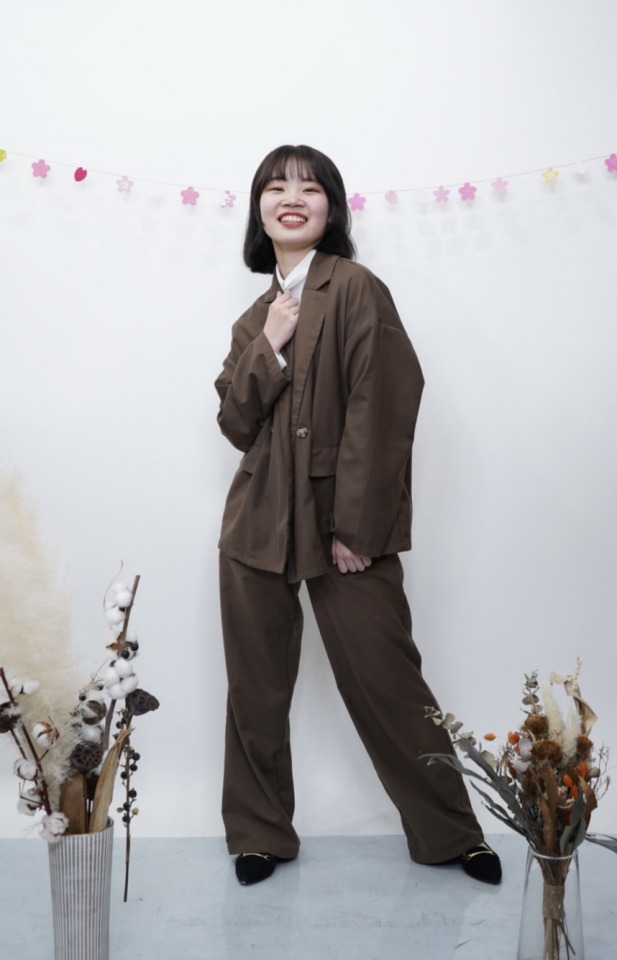
以上簡単ですが自己紹介とさせていただきます!自分が感じたことを綴っていきますので見に来ていただければ幸いです🌟
Self Introduction
Hello!
I’m Haruna, a new internship student at CGN, from April to December, 2024.
Nice to meet you😊
Firstly, I will introduce myself.
University
I’m a student majoring in Philippine Studies at the School of Foreign Studies,Osaka University, Japan. I have been in Baguio for a week right now. Mastering Filipino is very difficult…😢
〇Why did I choose Filipino for my major?
・I wanted to learn something different from other students!
・My future goal is working for tourism, and many Japanese people visit Philippine for their sightseeing
・The Philippines are safe!
・No need to learn new characters because Filipino can be spelled in Alphabets
・Mixed culture of the indigenous’s one, spanish and Americans was interesting for me
・My favorite English teacher of high school was Filipina
・I wanted to visit Cebu and see a beautiful beach while drinking coconut juice:)
(I’m staying in Baguio tho^^; I’d like to visit there soon!)
How could I meet with CGN?
I was planning to stay in the Philippines to improve my Filipino for a long time. In addition, I wanted to do something that I can communicate with people in the Philippines, not just learn something at the University on my own. I searched on the internet and found some blogs written by internship students of CGN. I was fascinated by them because they had experienced many kinds of things they wanted to do.
My favorite things :)
Dance!!!
I’m practicing locking dance, like Michael Jackson,,,!?
Singing♬
I belonged to the chorus when I was a child. I already miss Japanese karaoke^^;
Thank you for reading!!!
Magandang hapon po! Kumusta po kayo?:)
Si Haruna ako, student ako po sa Osaka University, Japan.
Nag-aaral ako ng Pilipino. Mag-usap tayo!
Maraming salamat po! Agyamanak apo!♡
0 notes
Text
ご無沙汰しています。拙い英語な私に、わかりやすく、色々と教えてくれるスタッフに感謝が絶えないあんどうです。
サンファンという今ではサーファーの若者のメッカのようになっている場所で、そんな場所になる前からコーヒーのお店を開いていた、CGNのパートナーに行ってきました。
名前は、El Union。サンファンでコーヒーショップを始めたのは10年ほど前。 8年来のCGNのパートナーです。
おしゃれ…
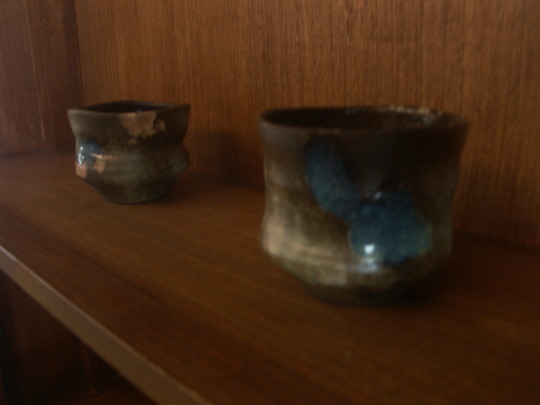
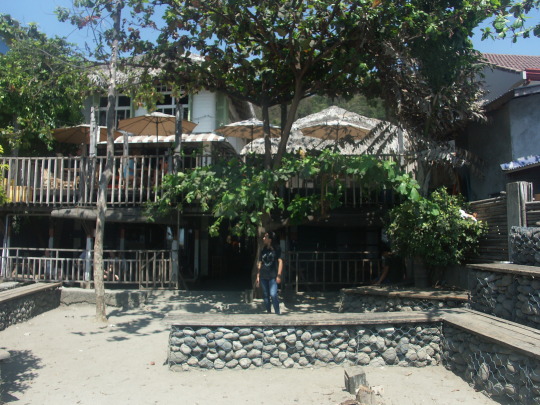
訪問した水曜日は、お店はお休みだったようで、それでも多くのお客さんがお店やビーチを訪れ、バケーションを楽しんでいました。私達がお店の中で話を聞いていると、コーヒーを目当てに来たのか、お休みしていると知るととても残念そうな顔で帰っていく人もいるくらいの人気ぶりです。
コーヒーは、産地にも、品種にも、ローストのやり方によっても味が全く違います。フィリピンの高地では、CGNが関わっているような、アラビカ種、それ以外のところでメジャーなのはロースター種と呼ばれるものです。お恥ずかしながら全然コーヒーについて知らなすぎて見当違いなことばかり言っていたら、ロブスター種とアラビカ種のコーヒーを見せてもらうことができました。
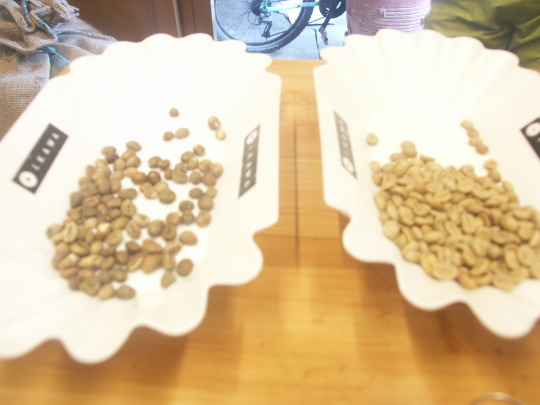
左側が、、ロブスター種。(いい写真がなくごめんなさい…)香りは深くて甘くて、といった感じで、癖のあるはちみつのような深い感じを受けました。(わかる人にはわかるでしょうか…クリのはちみつのような感じの香りです)そして右側がアラビカ種。アラビカ種は高地で作られるため、ウォッシュド製法で作られることが多いのも関係しているのでしょうか?スッキリとした香りです。
生豆の色も全然違っていて、ロブスター種は深めの緑、茶色に近くてコロンとしている、アラビカ種は薄めの緑色で片面は平べったい、そんな違いがあります。
CGNから生豆を仕入れて、このお店でローストしているのですが、コーヒーの味を決める非常に重要な要素の一つである、ロースト、ここにものすごくこだわりがあるそうです。なんとこのお店の焙煎機はコンピュータ搭載。機械が温度や時間、弾けるようなコーヒーの動きを感知し、コンピュータで管理しつつローストをしていきます。
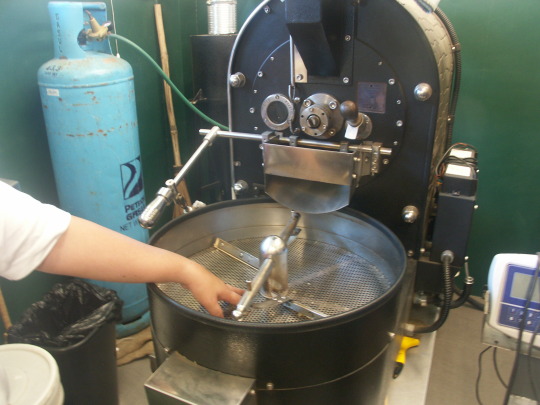
最初は豆の香りが、段々フルーツのような、オレンジのような、香ばしいような、と香りが変化していって、その香りを頼りにローストするのだと、もともとバリスタでCGNのスタッフとしても一時関わっていた、最近コーヒーの焙煎もしているタンさんが教えてくれました。
このローストが、コーヒーの味に大きな影響を与えるため、農家さんの作ったコーヒーを価値あるものとするかは、ローストする人がどれだけそれを引き出せるかによります。コーヒーに価値をつける、これをしたくてこのお店でローストしているそうです。
昔は美味しくないと、需要も少なかったコーヒーを、今や大人気のコーヒーとした、このショップから、そのものの価値を引き出すべく、サプライチェーンのそれぞれの場所で活躍する人の重要性を感じました。そして、そんな人たちのことを知り、身近になるとそのものが一気に身近で温かいものになる。人の想いが載ったものになる。そんなことがちょっとでも伝わったらと思って今ブログを書いています。
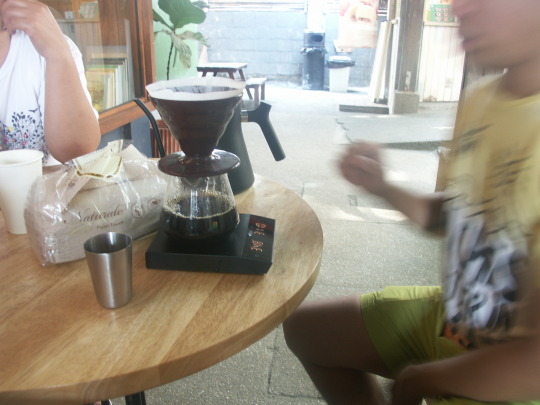
実際にタンさんが淹れてくれたコーヒーは、今まで思っていたコーヒーとは全然違くて、スッキリしていて、ちょっと甘くて、サトウキビと言われたらそんな感じの香りがして、オレンジかレモンみたいな柑橘系の感じもあって…と、すごく面白かったです。美味しかった…これがフィリピンのコーヒーなんだよ、と。
(CGNスタッフのリリーは本当にコーヒーに詳しく、ロースト時間とか、方法とか、ピーチの香りがするね、とか…)
こんな人たちの手が加わってできていくコーヒーを、ぜひストーリーと共に楽しんでほしいなあと思います。
ここまでお読みいただきありがとうございました!!
I went to a CGN partner who opened a coffee shop in Sanghwan, a place that is now one of the most famous place for surfers.
The name is El Union.They started a coffee shop at Sanghwan about 10 years ago.
They became a partner about eight years ago when we brought coffee to this restaurant.It seemed that the shop was closed on Wednesday when we visited, but many customers still visited the shop and the beach and enjoyed the vacation. We were allowed to enter the restaurant,but there were many people who came looking for coffee, and when they found out that they were taking a break, they left with a very sad face.
Coffee tastes completely different depending on the production area, variety, and roasting method.
In the highlands of the Philippines, the arabica species, such as the CGN growing, and elsewhere the major ones are called roasters.I'm ashamed to say that I didn't know anything about coffee at all, so they showed me roaster and arabica coffee.
The Right side is the roaster species.The scent was deep and sweet, and I smell like honey.(For those of you understand…? it smells like chestnut honey.) And on the left is the Arabica species.Is it also related to the fact that arabica species are often made by the washed method ?It is refreshing and has a rather citrus-like scent.
The color of the green beans is very different, the roaster species are deep green, close to brown, and the Arabica species are light green and flat on one side.
They buy green beans from CGN and roast them at this coffee shop, and they are very particular about roast, one of the very important factors that determines the taste of coffee.Surprisingly, all the roasting machines in this coffee shop are automatic.The machine senses the temperature, time, and the movement of the coffee that it can play, and the craftsman control the roast.
Tan, who was originally involved as a barista and CGN staff, recently roasted coffee, told me that the aroma of beans gradually changed from fruit to orange to savory.
Because the roast has a huge impact on the taste of coffee, it depends on how much the roast person can pull it out.He say they roast coffee at this coffee shop because they want to make it worthwhile.
I felt the importance of people working in the parts of the supply chain in order to derive the value of coffee, which used to be less delicious and less in demand.Then, when you get to know these people, they become familiar and warm.We can feel these tought from coffee. I'm writing this blog because I feel that way.
In fact, the coffee Mr. Tan made was very different from the coffee I had thought before, and it was refreshing, a little sweet, and when it was called sugar cane, it smelled like that, and it had a citrus-like feeling like an orange or lemon. It was very interesting. This is Philippine coffee,he said.
(CGN staff member Lily is really familiar with coffee, roast time, method, peach scent, etc.)
I hope you will enjoy the coffee made with the help of these people along with the story.
Thank you for reading so far!!
0 notes